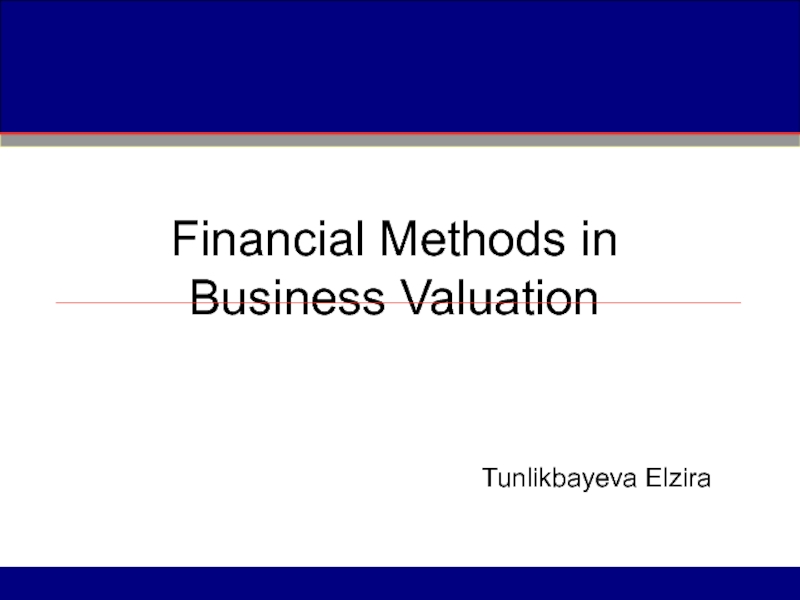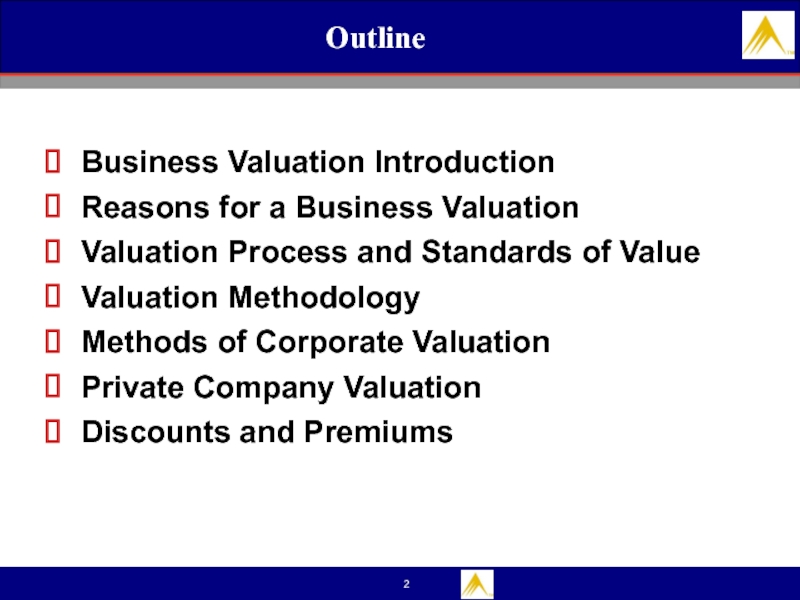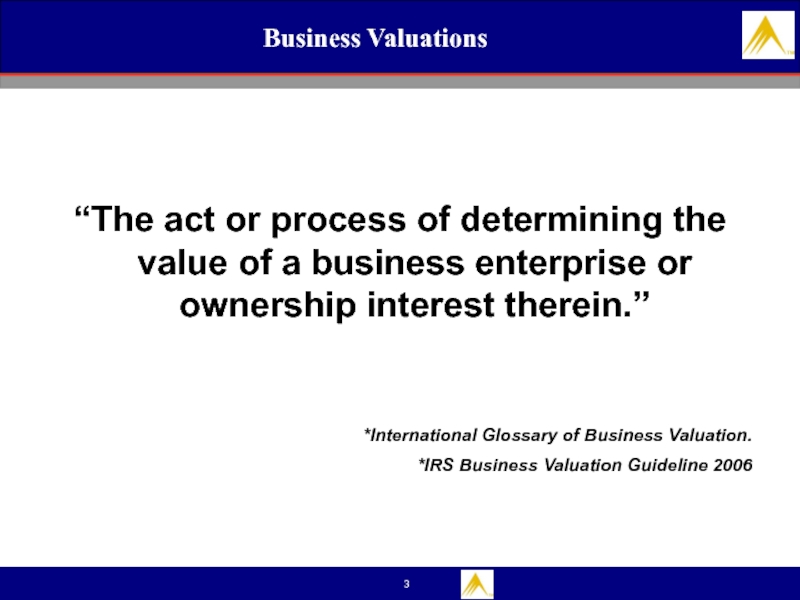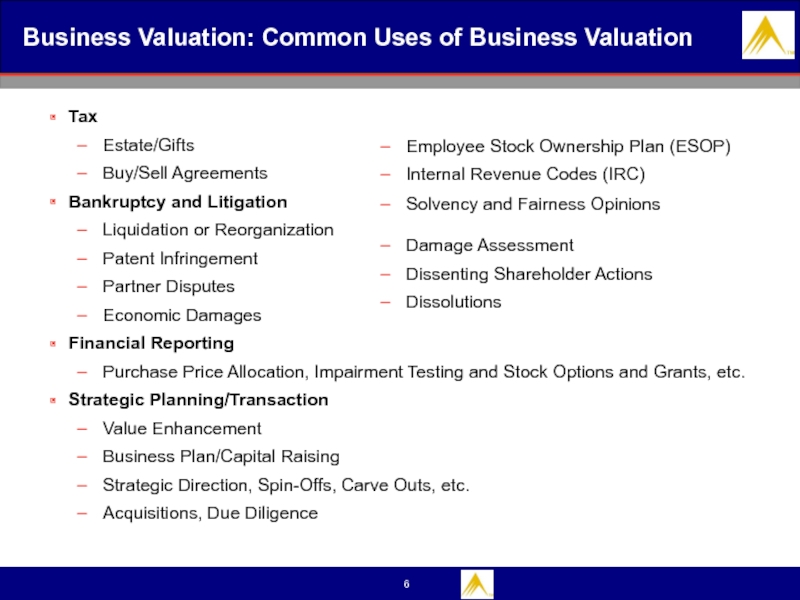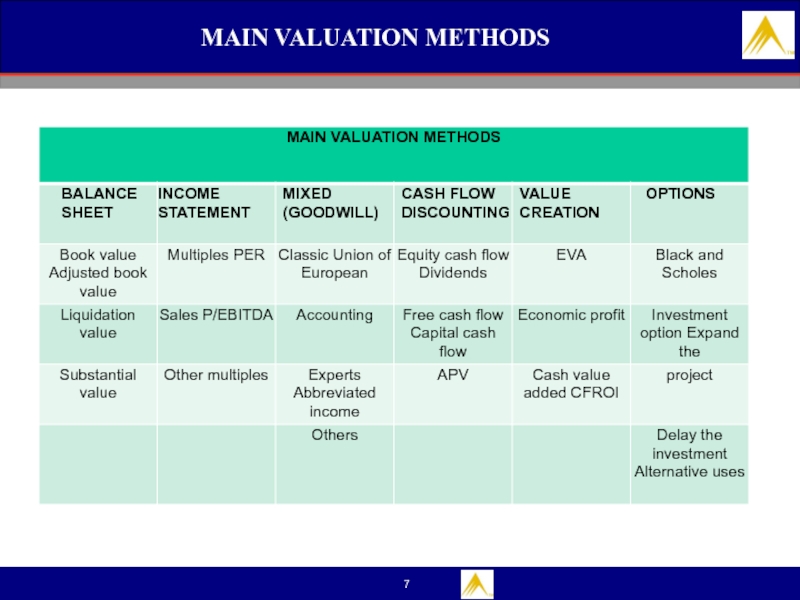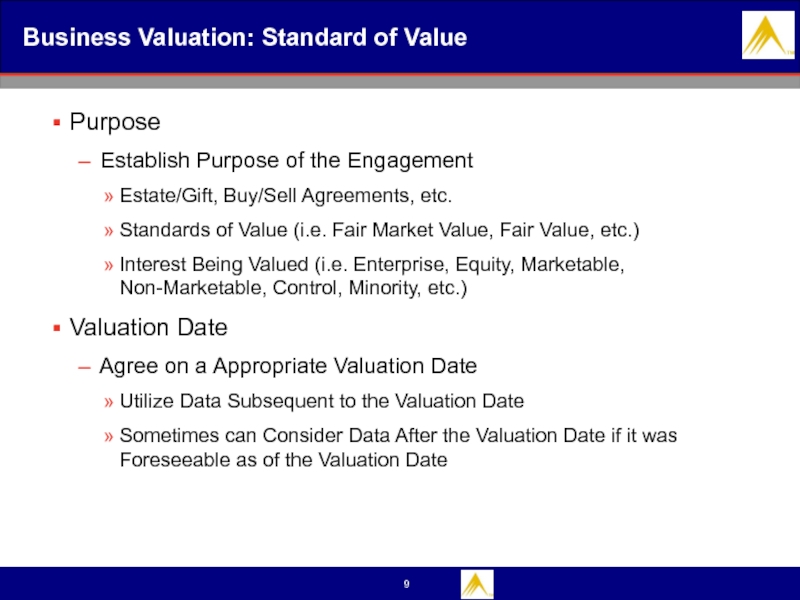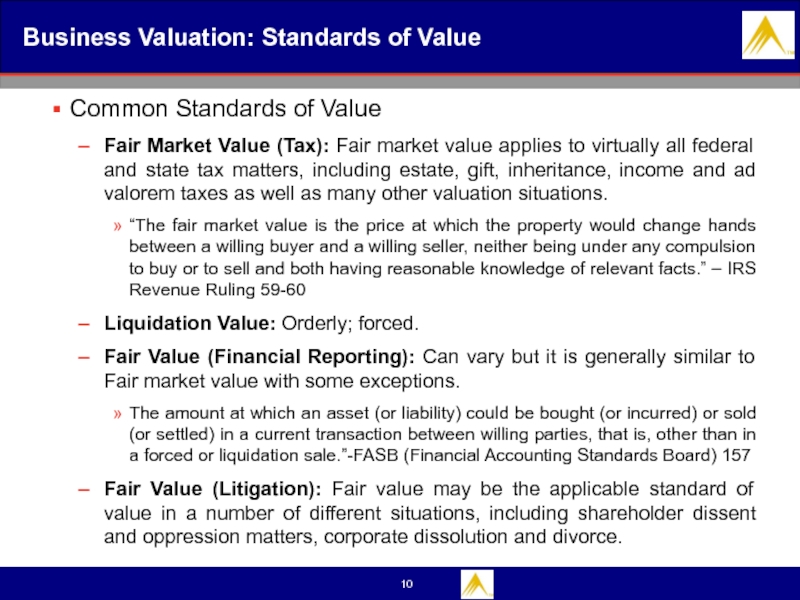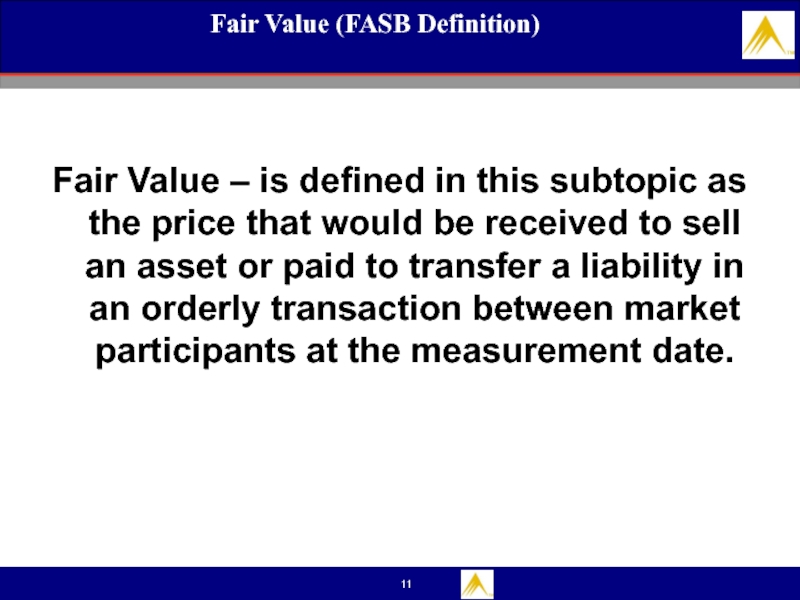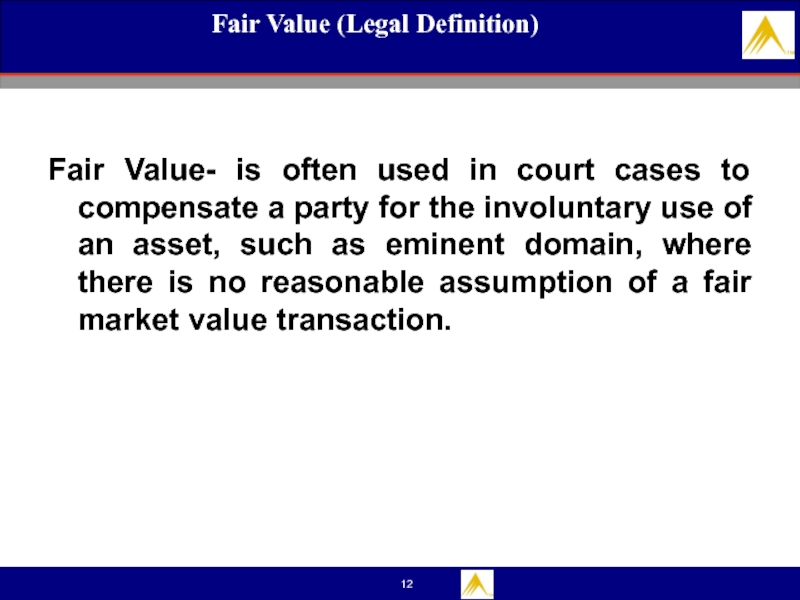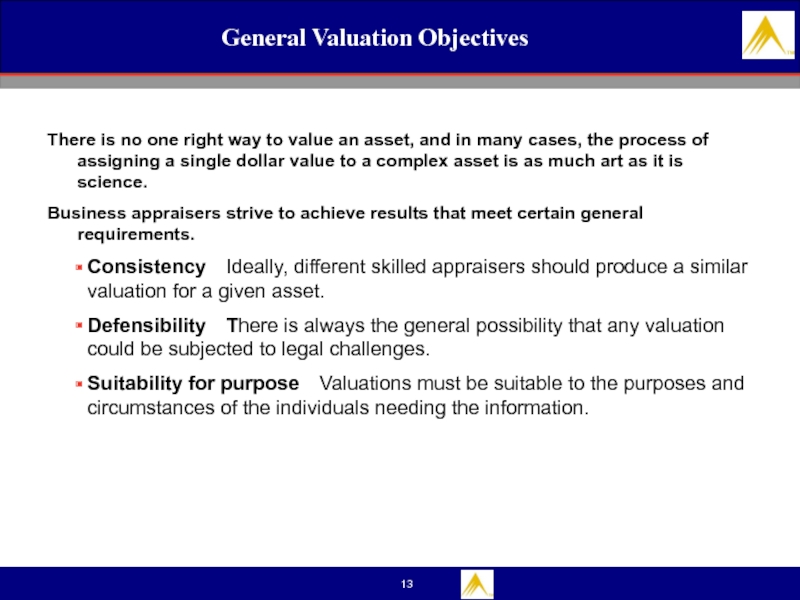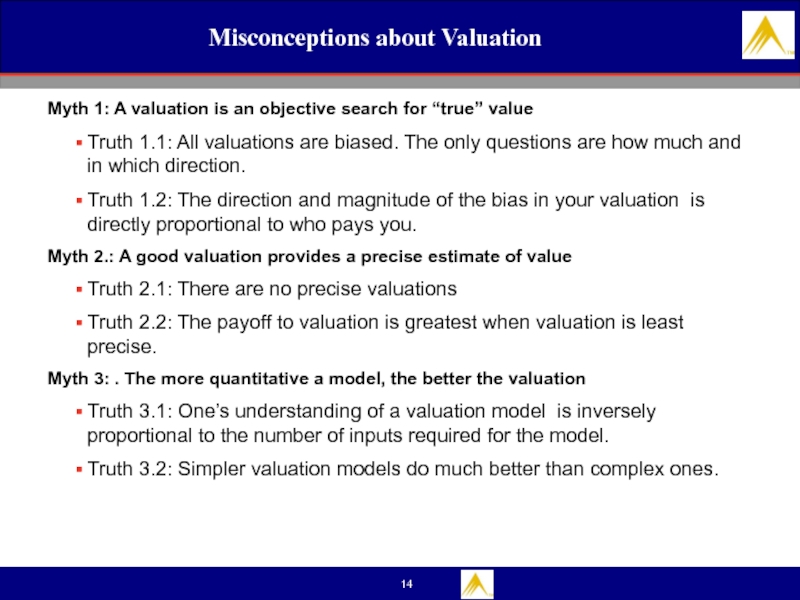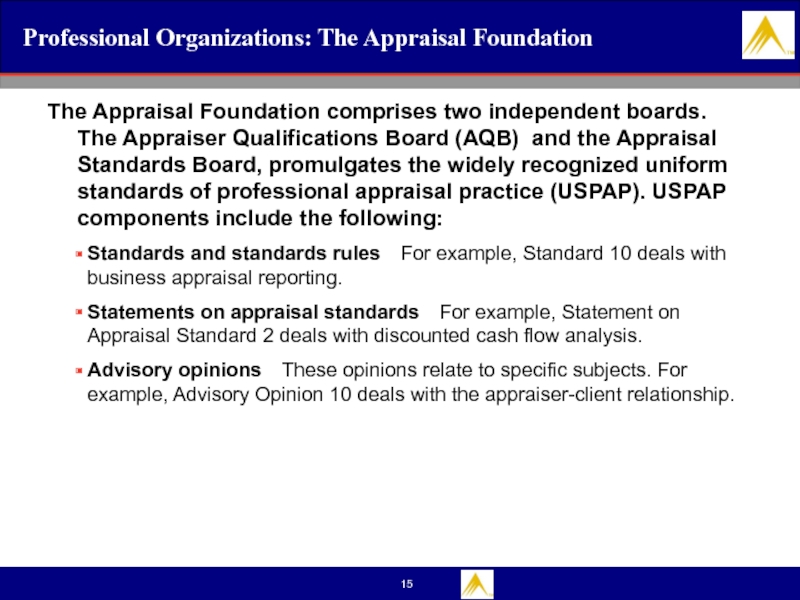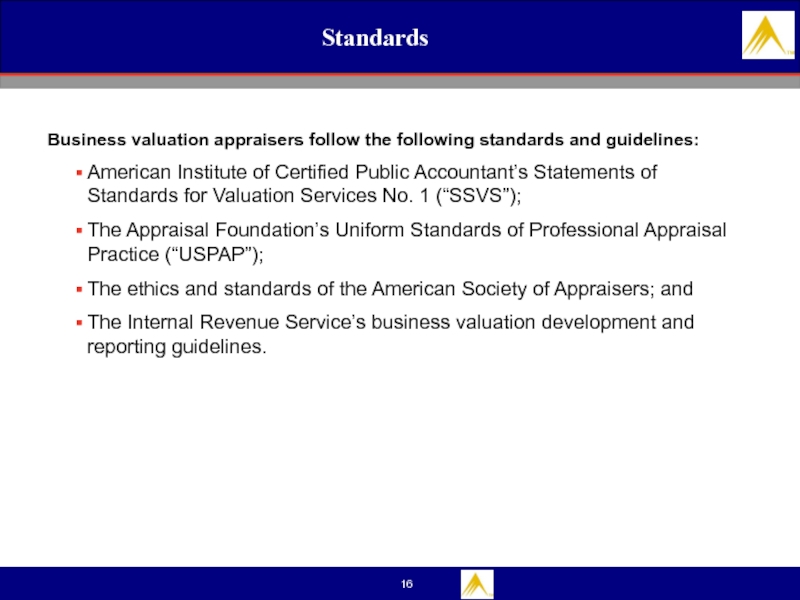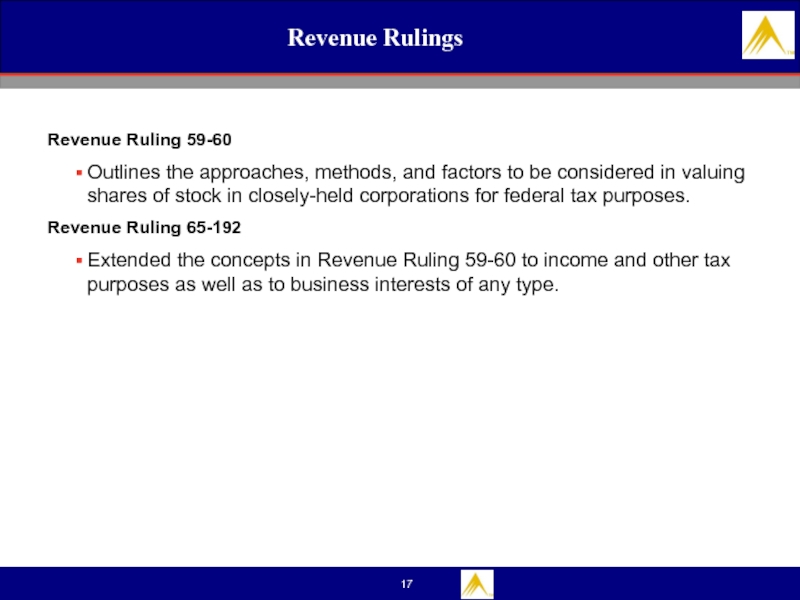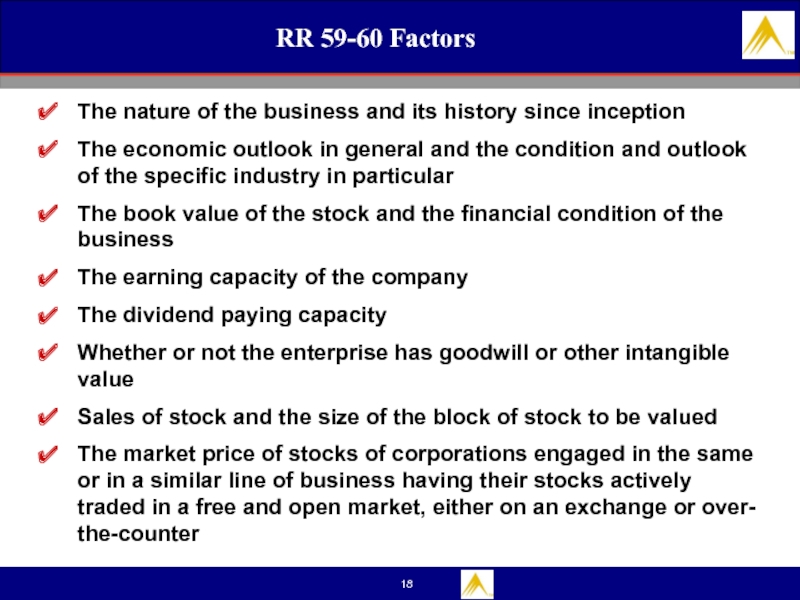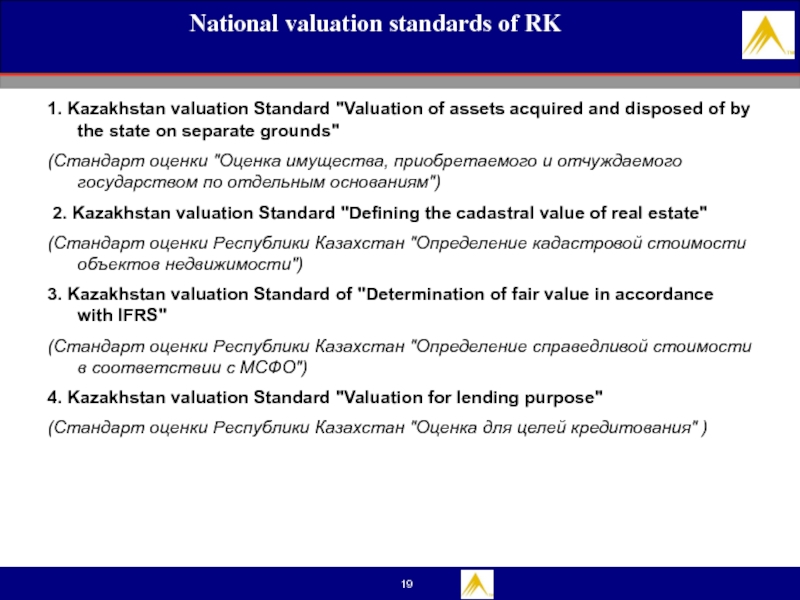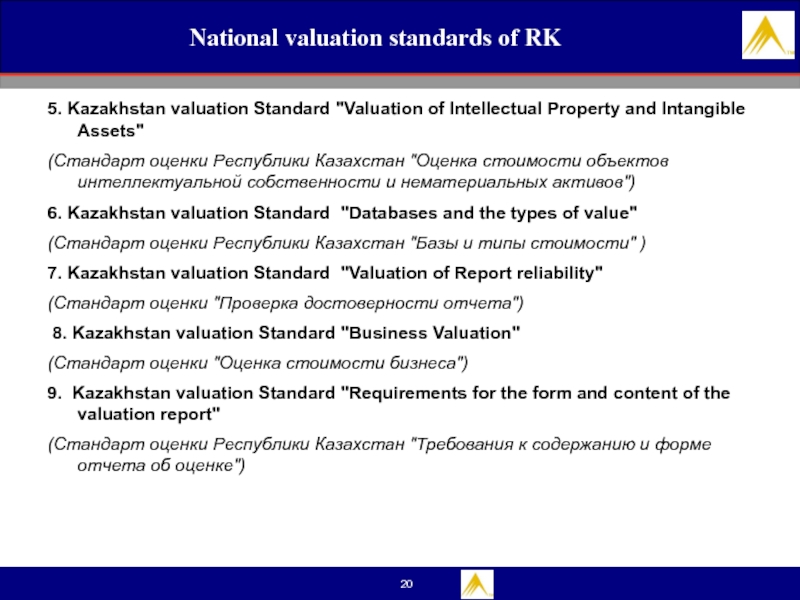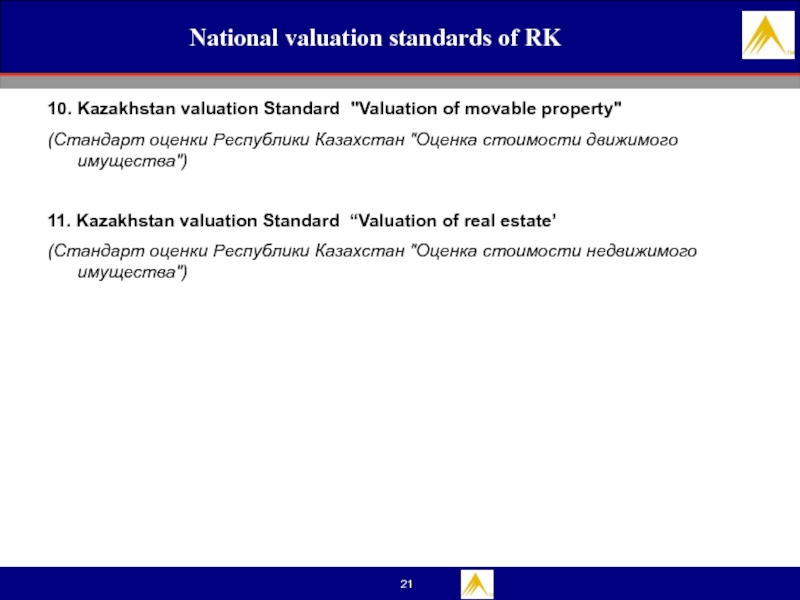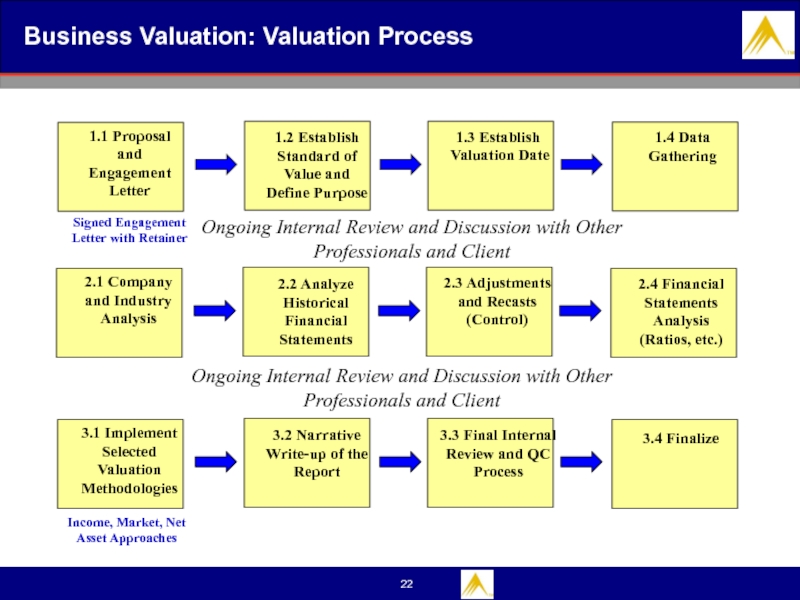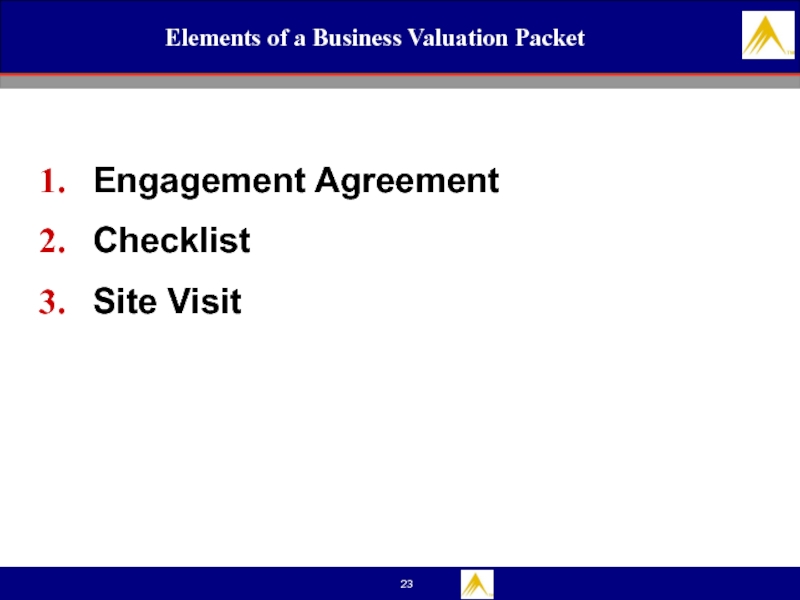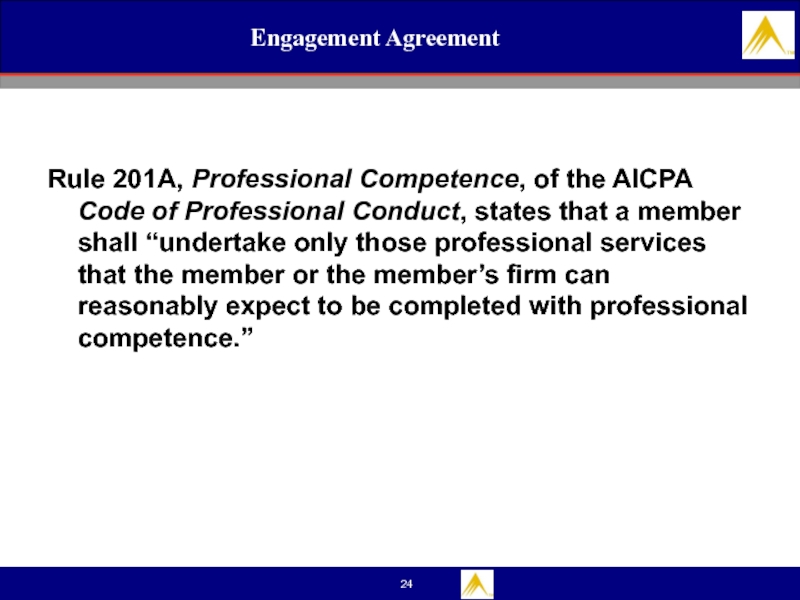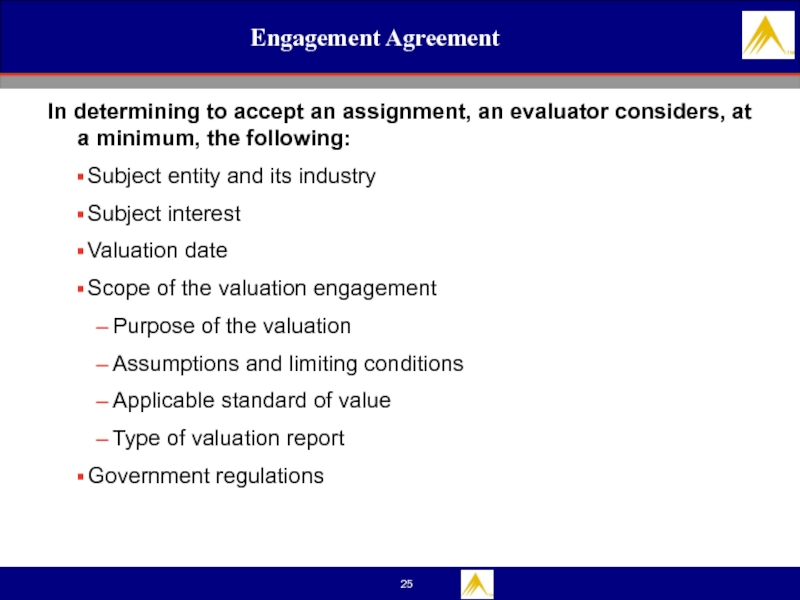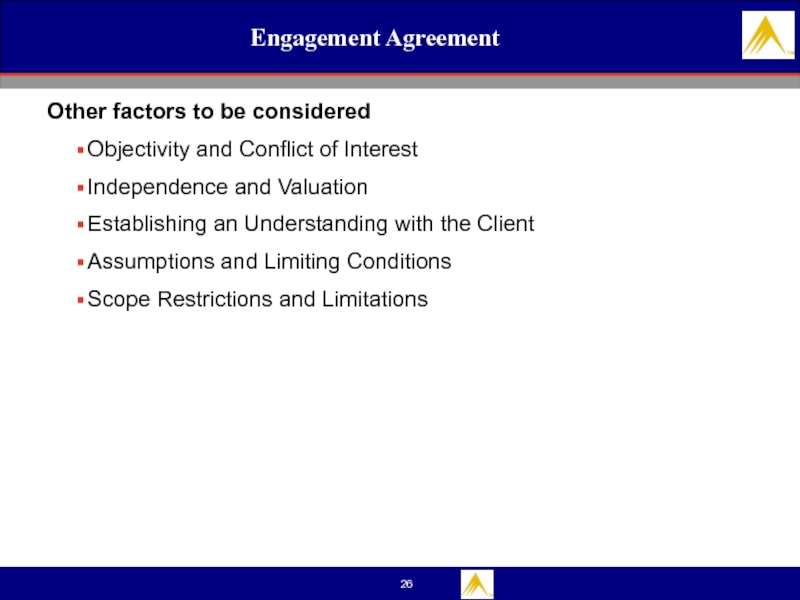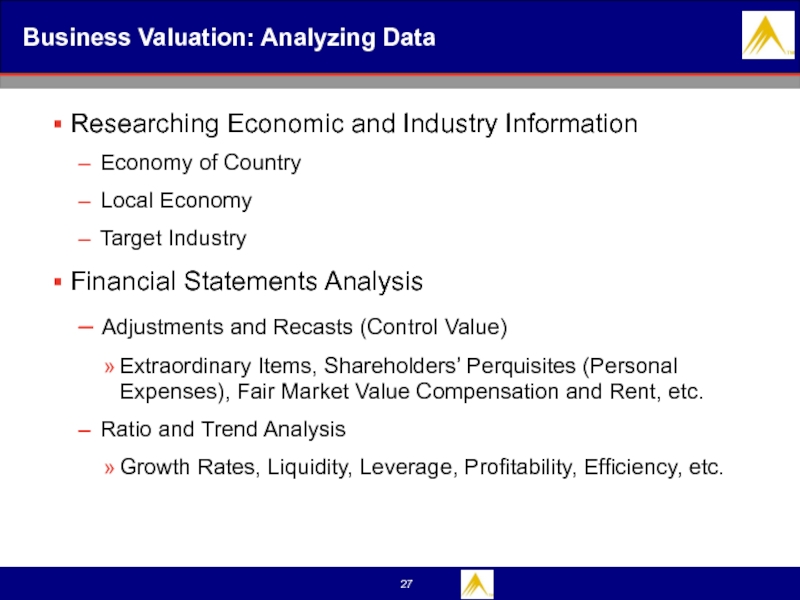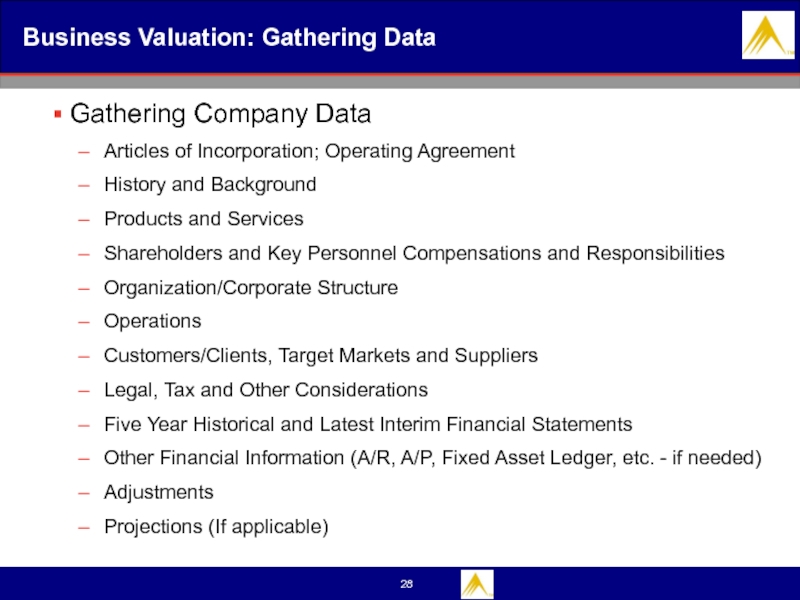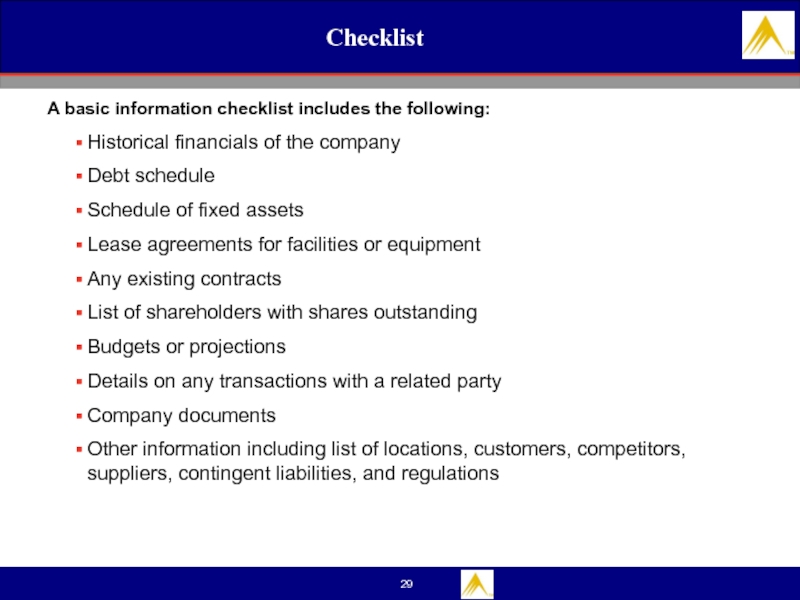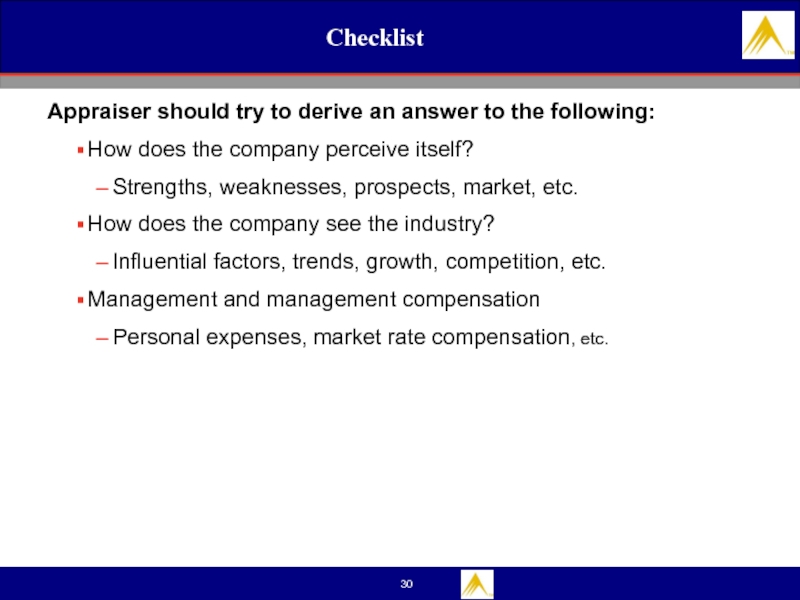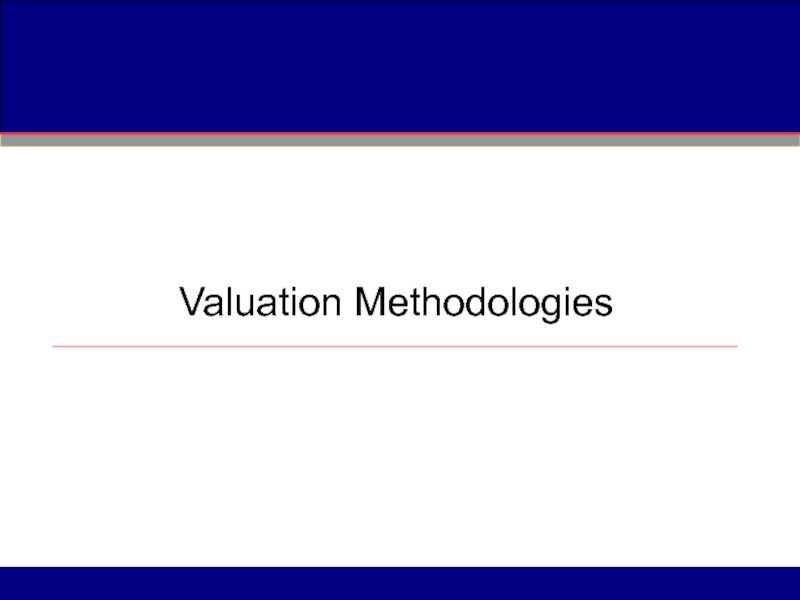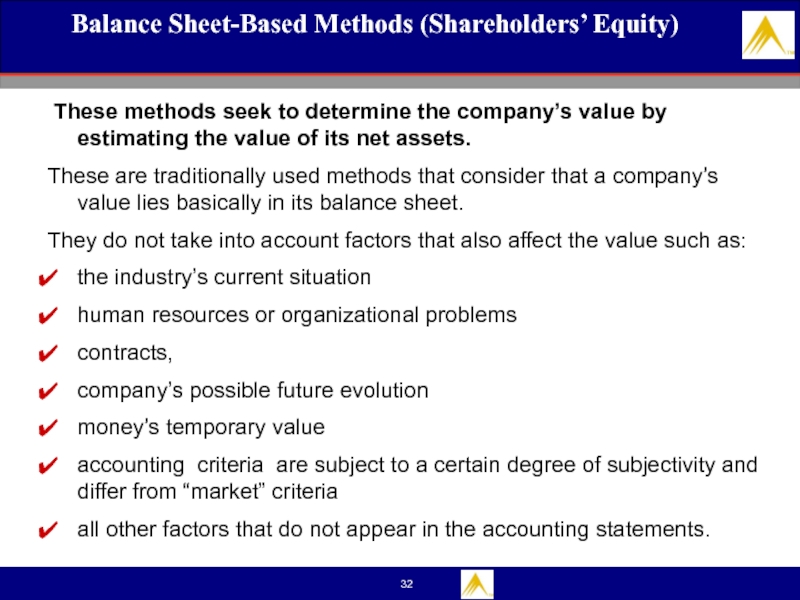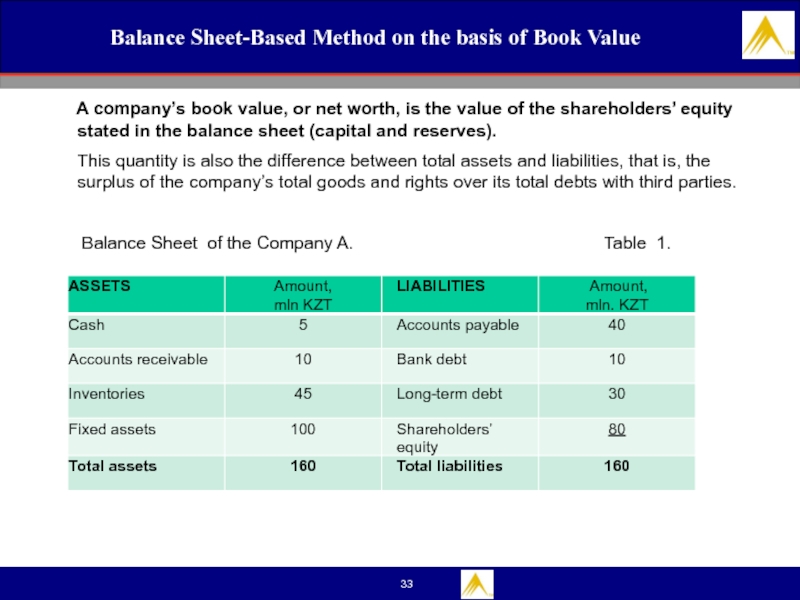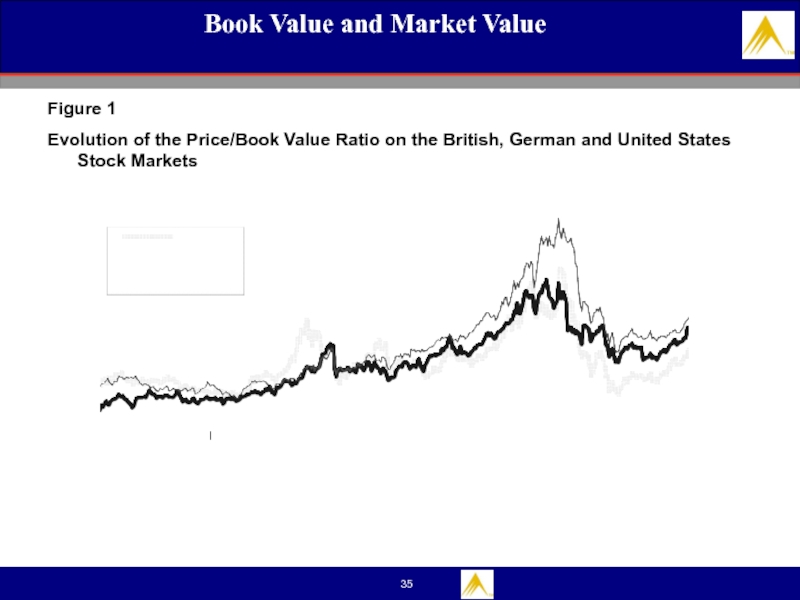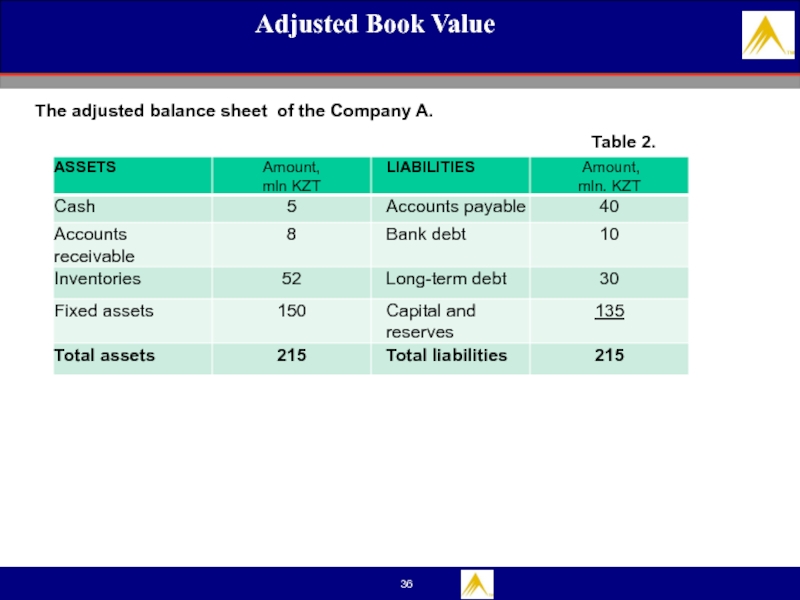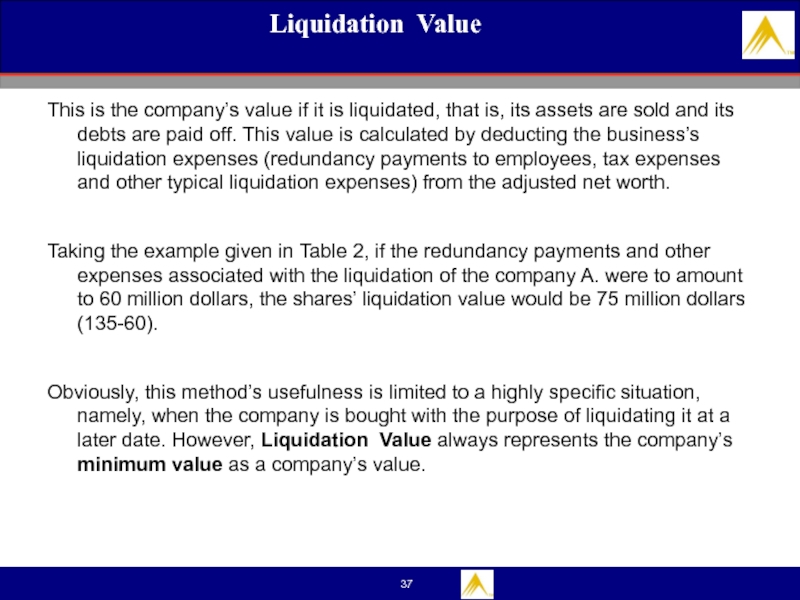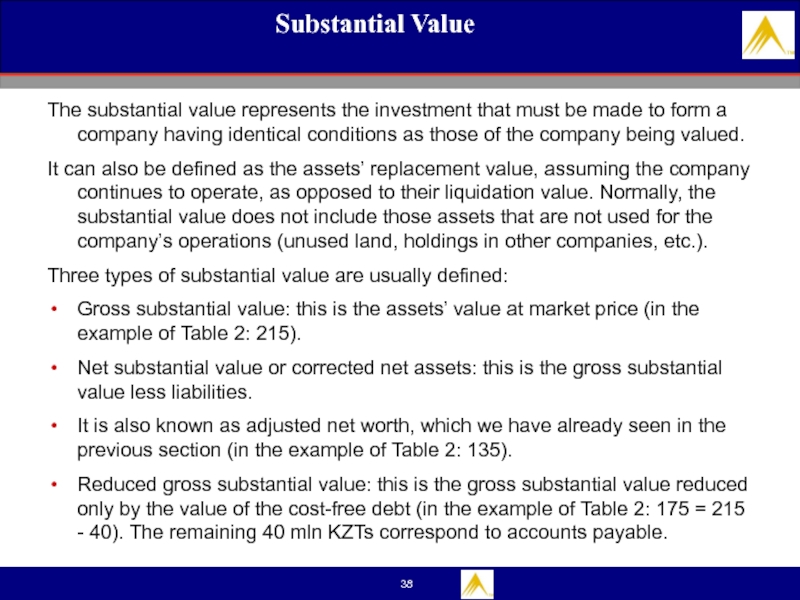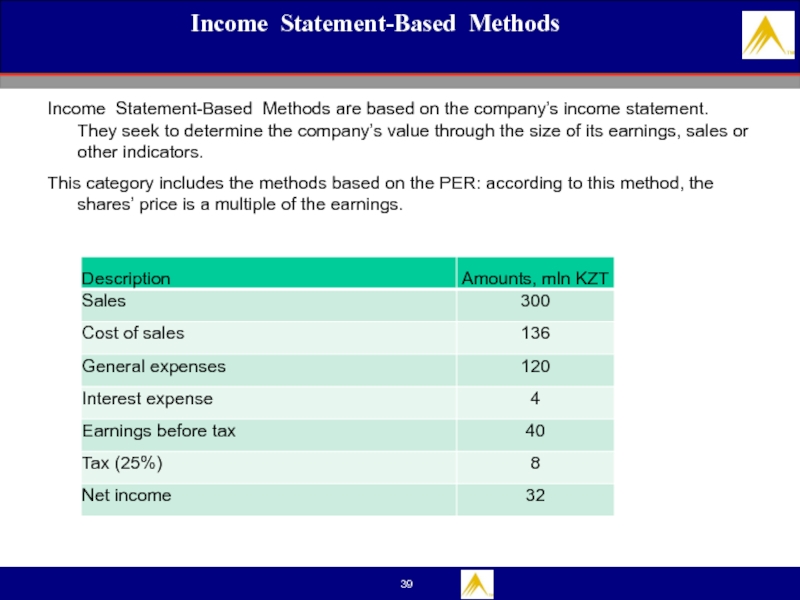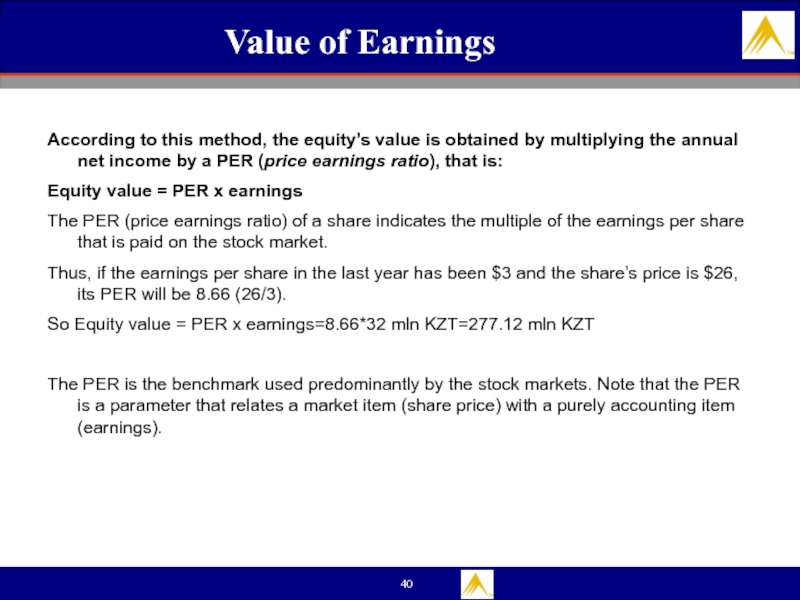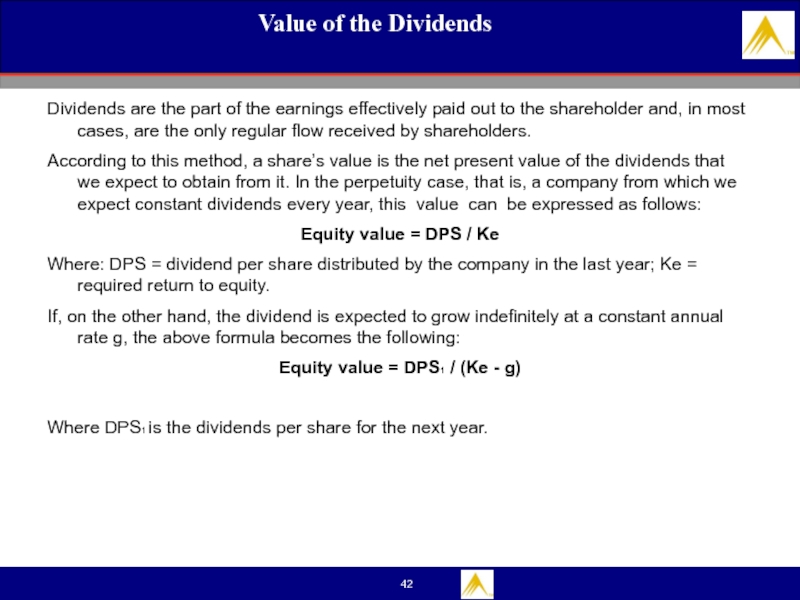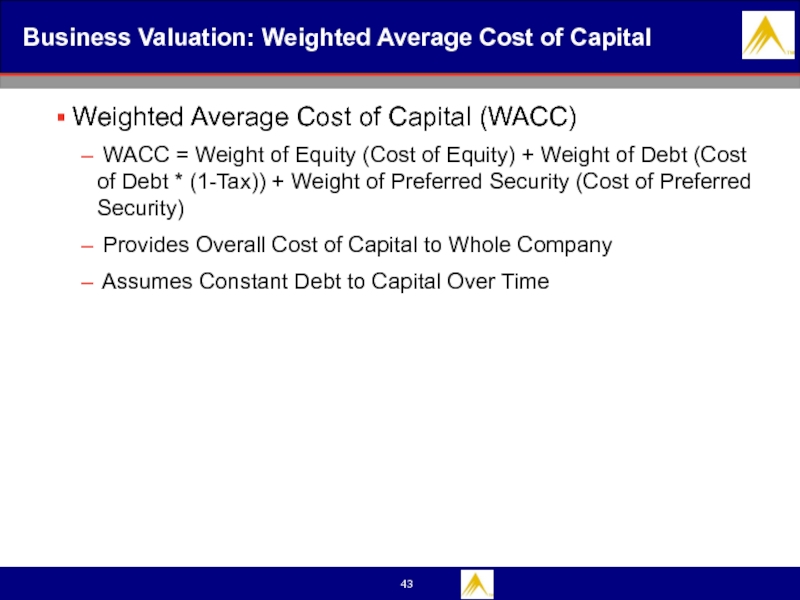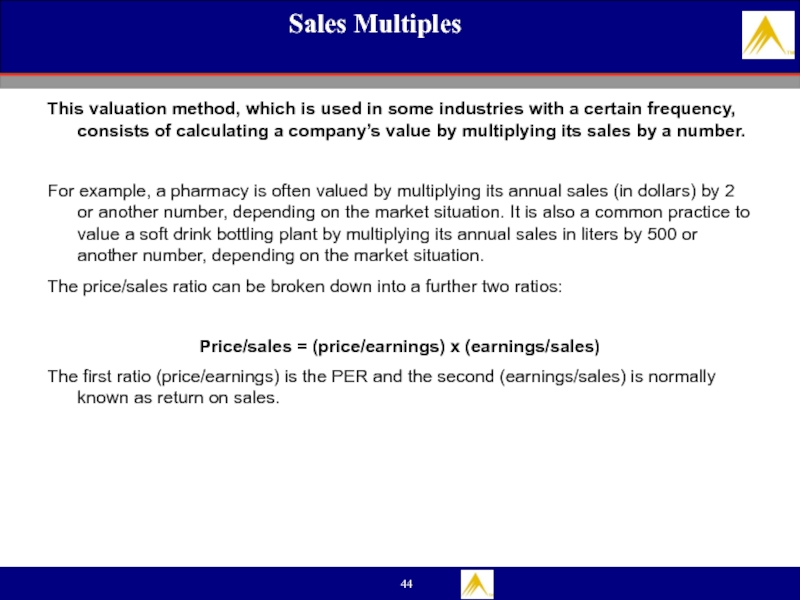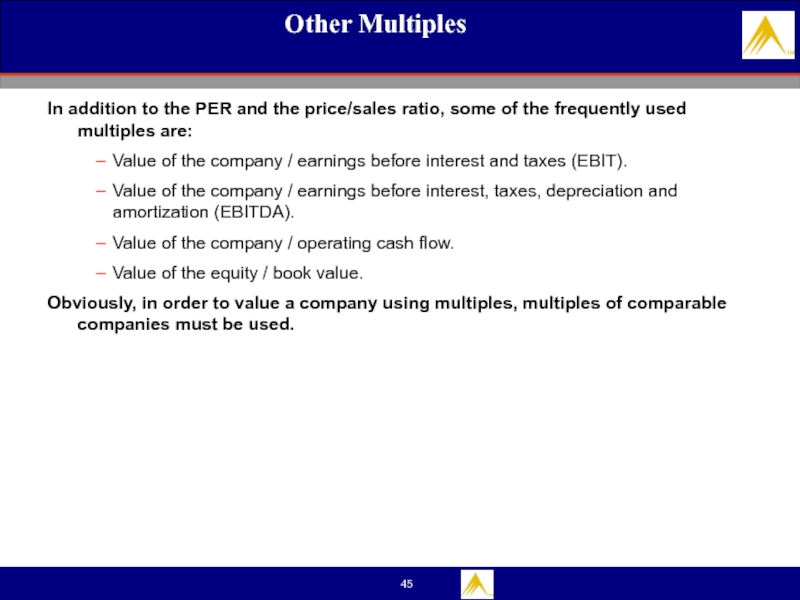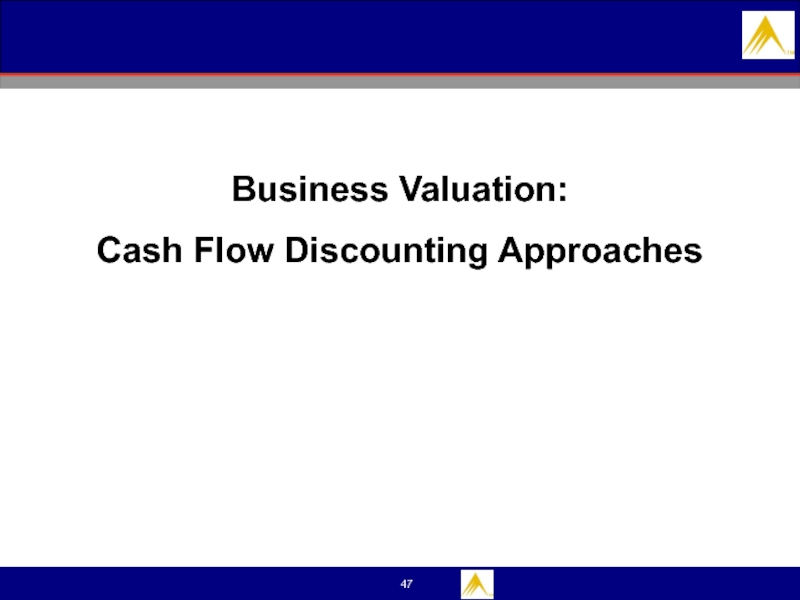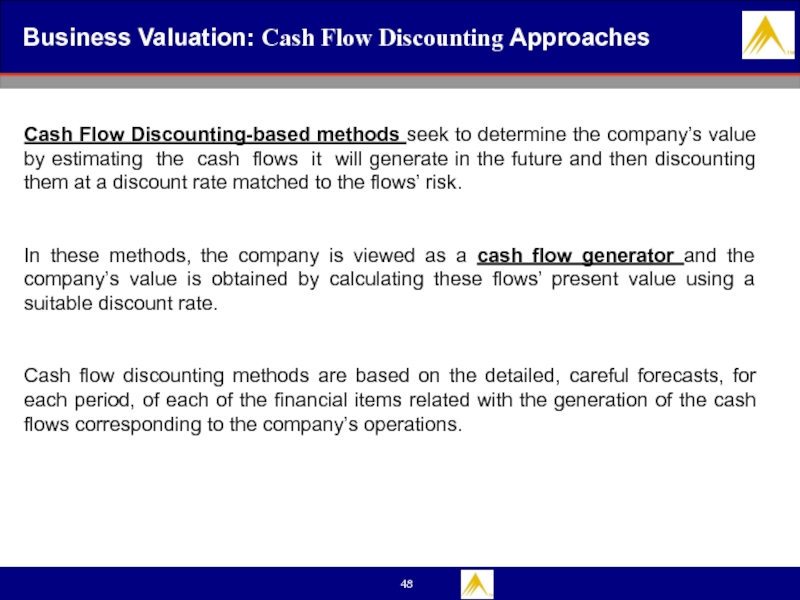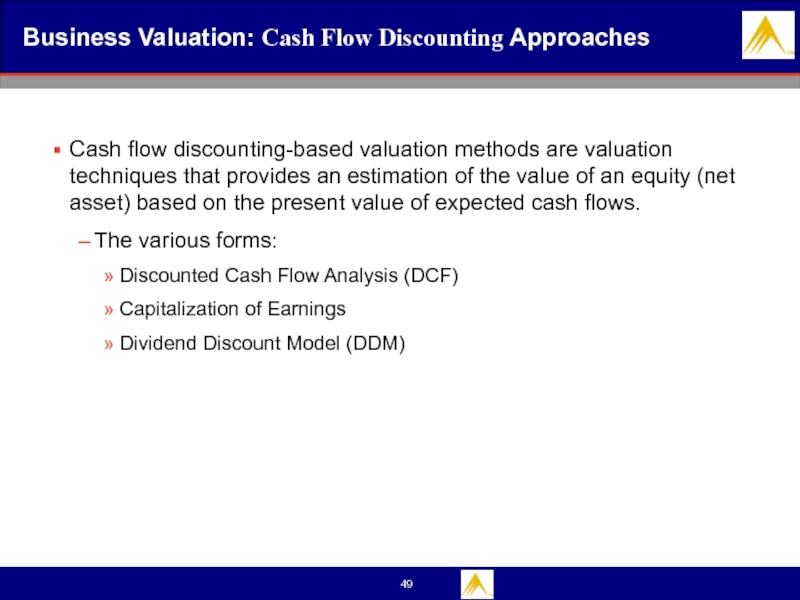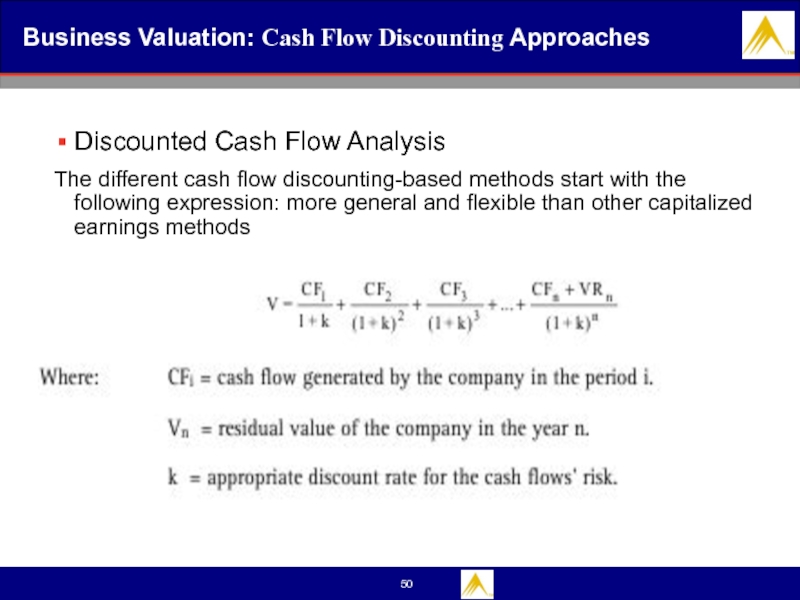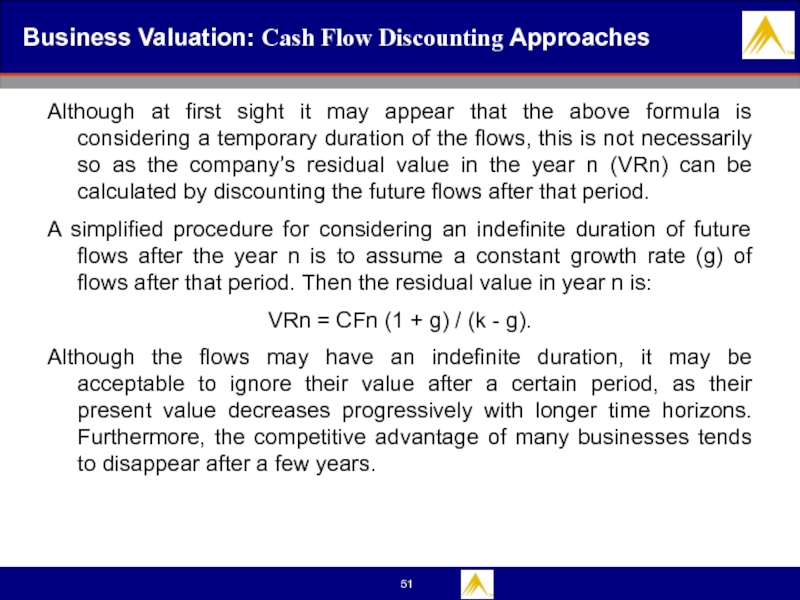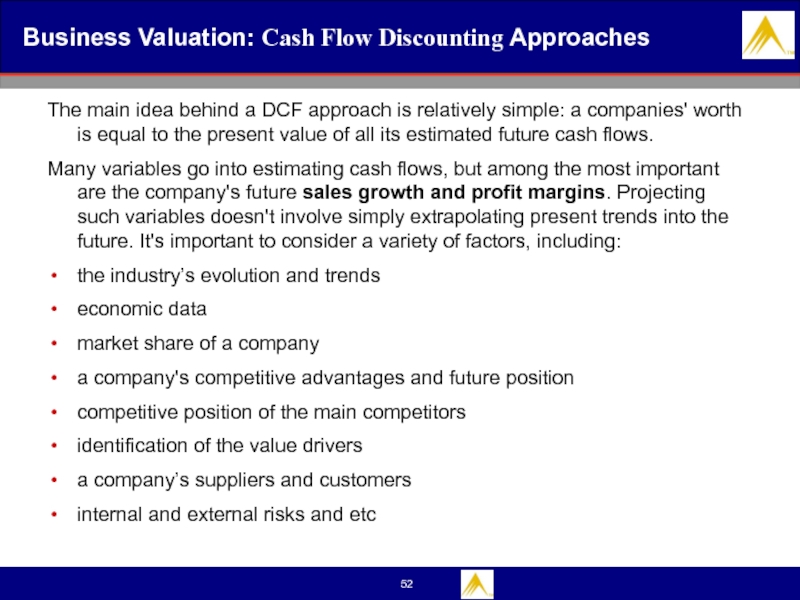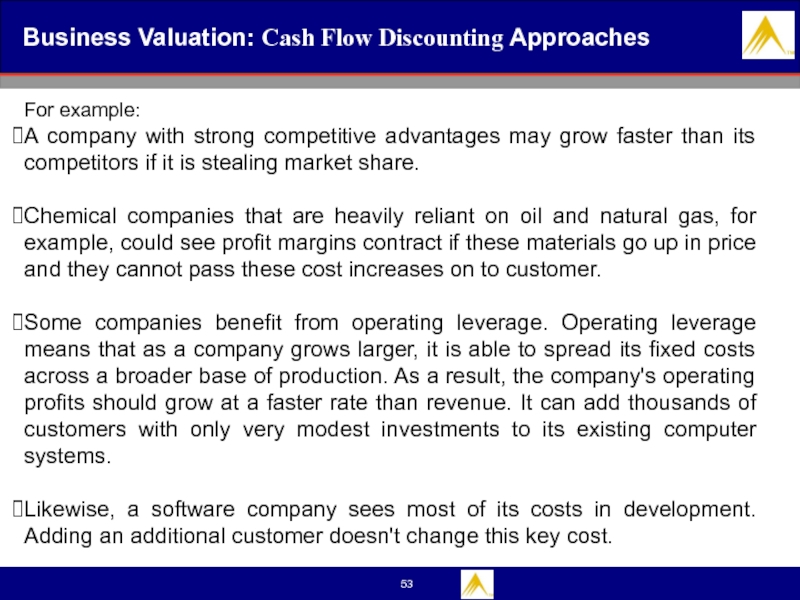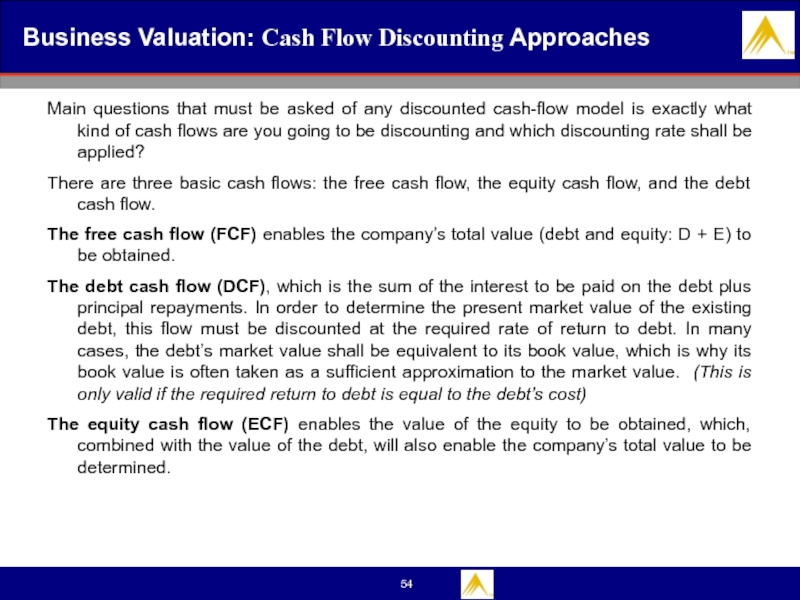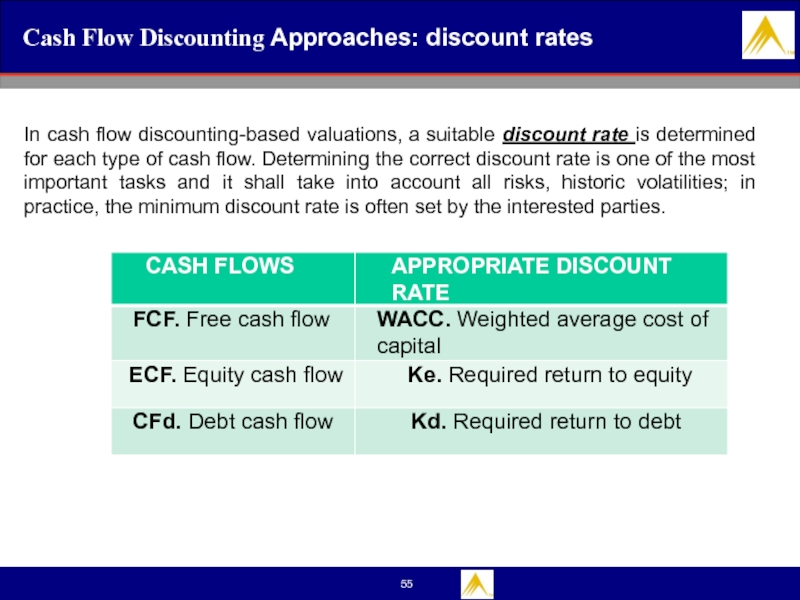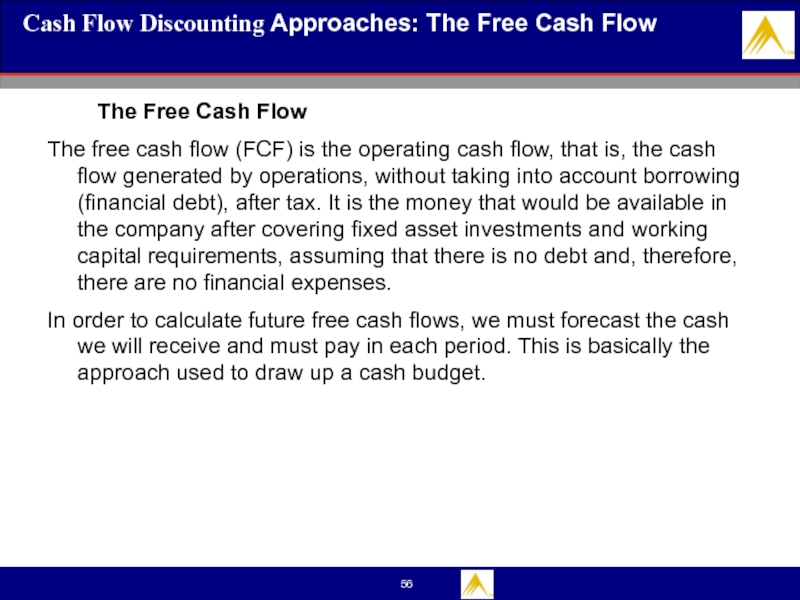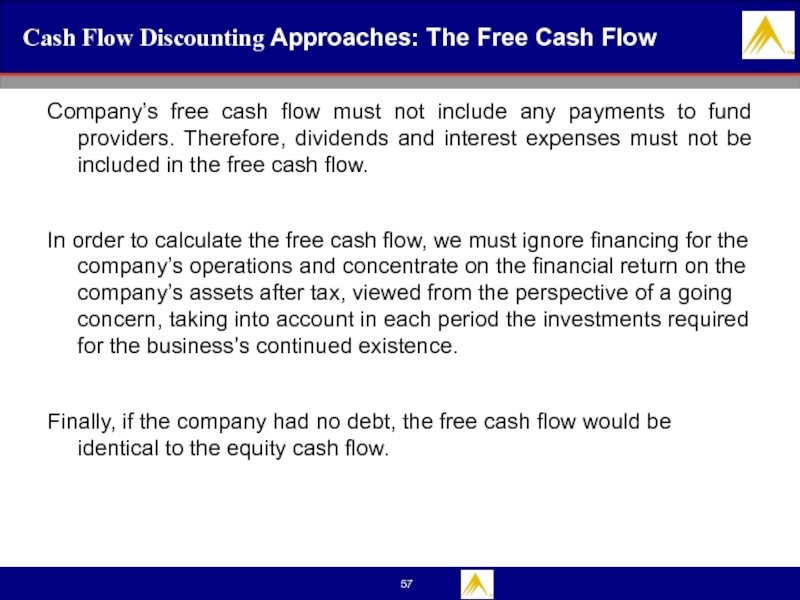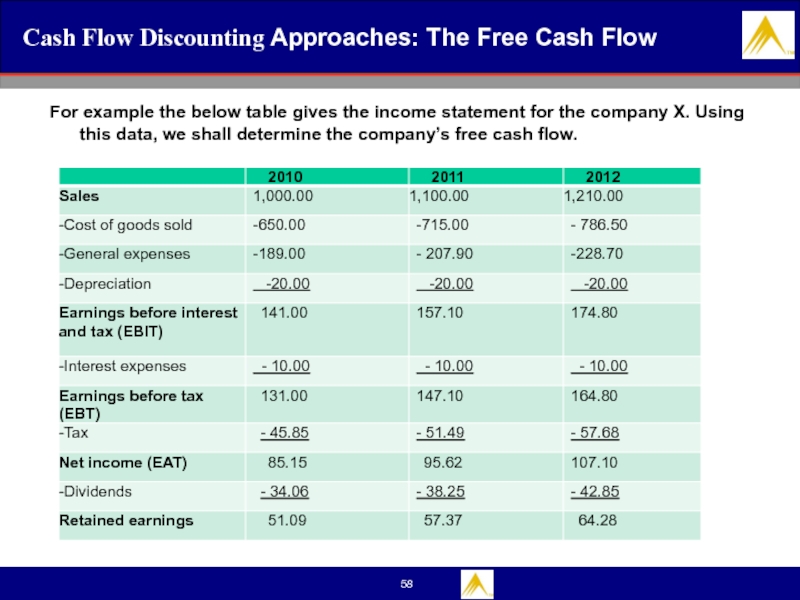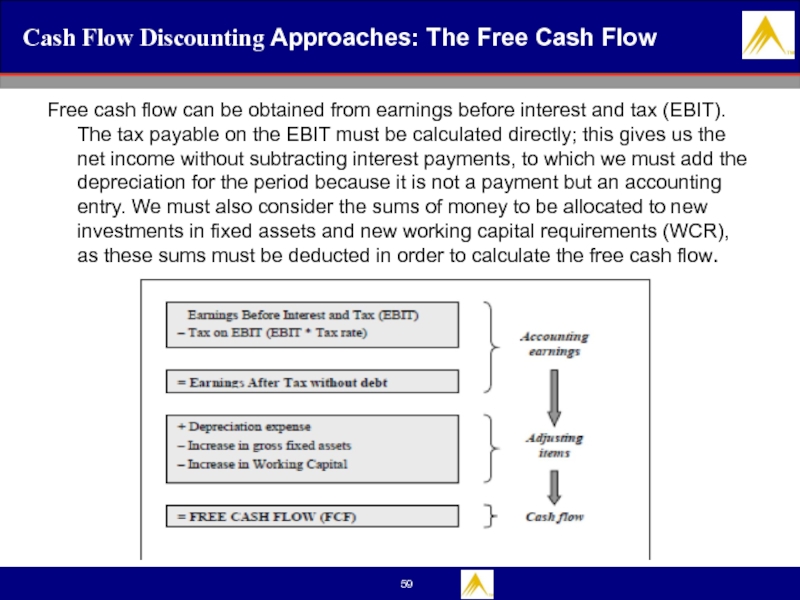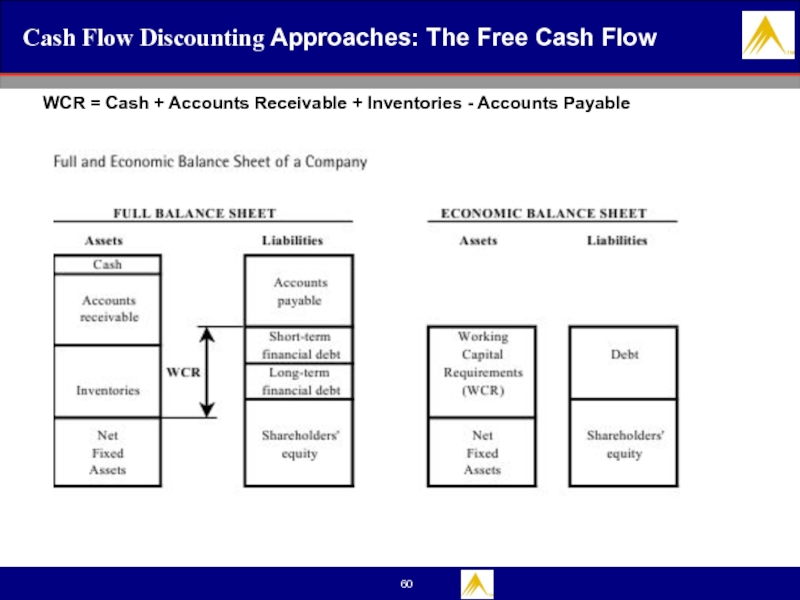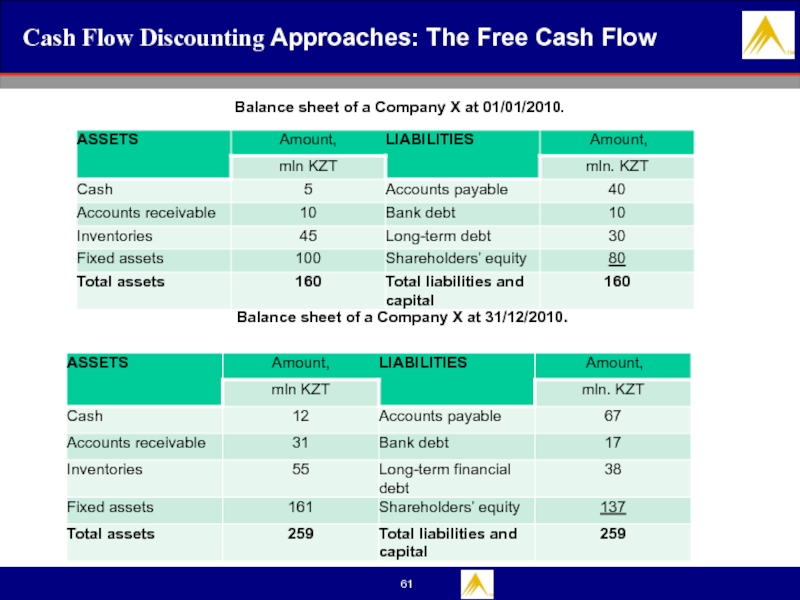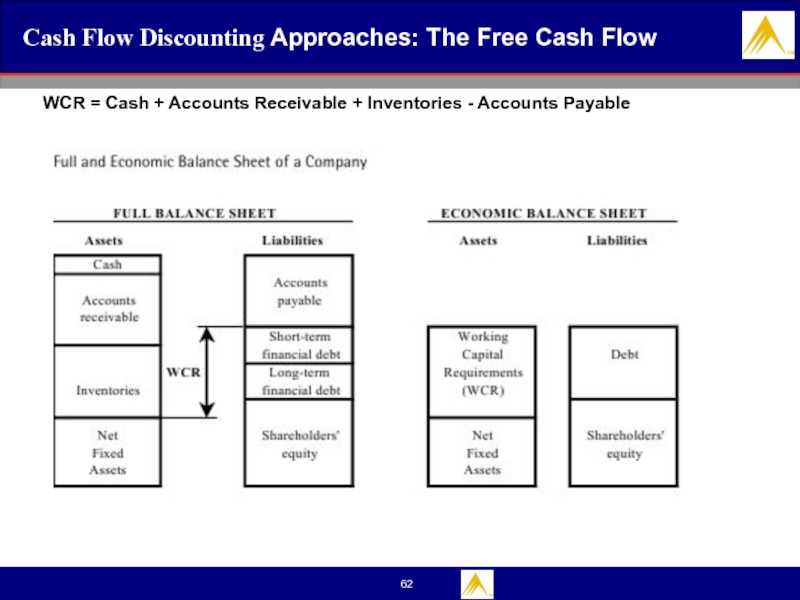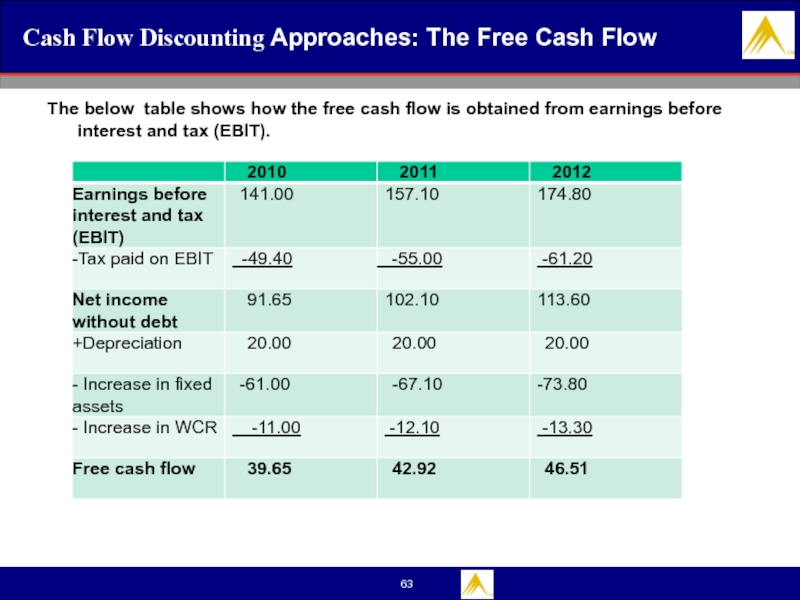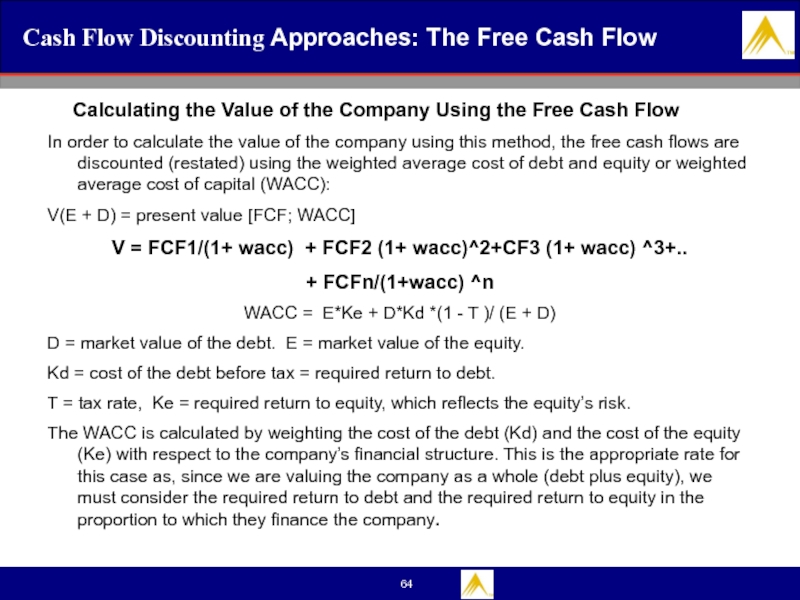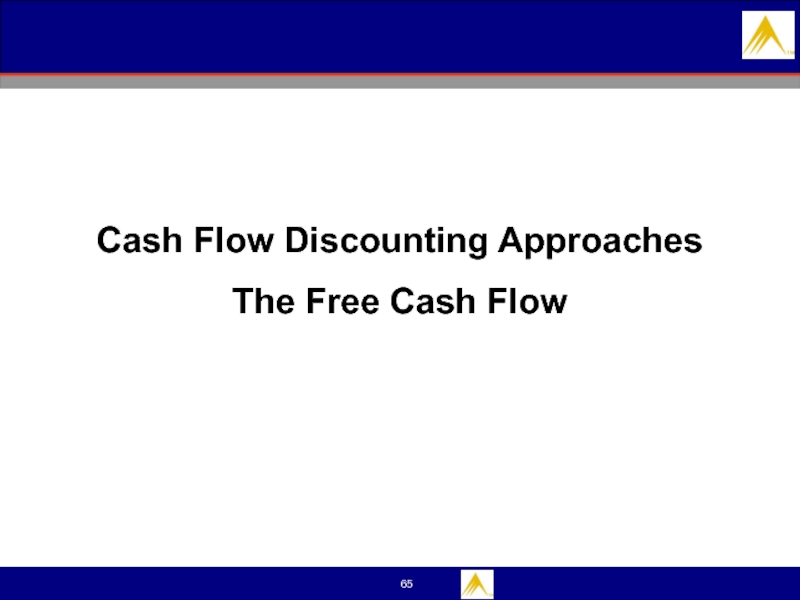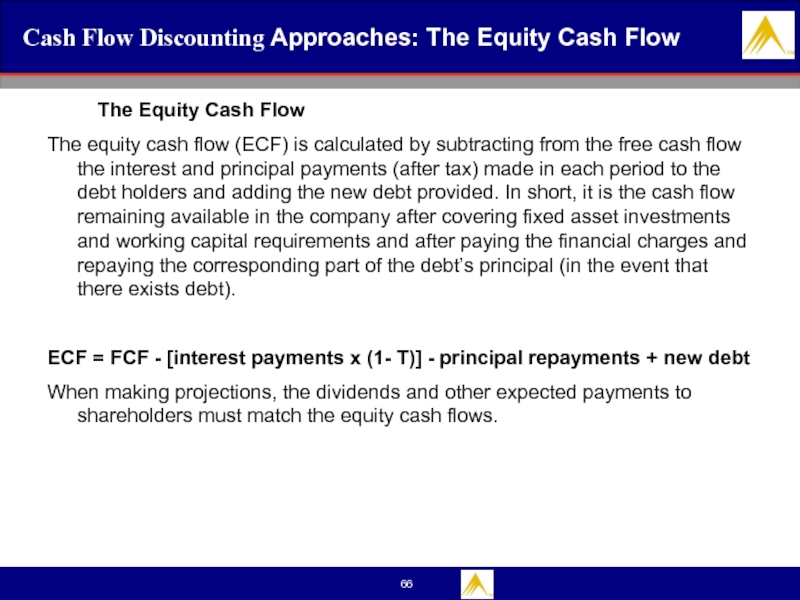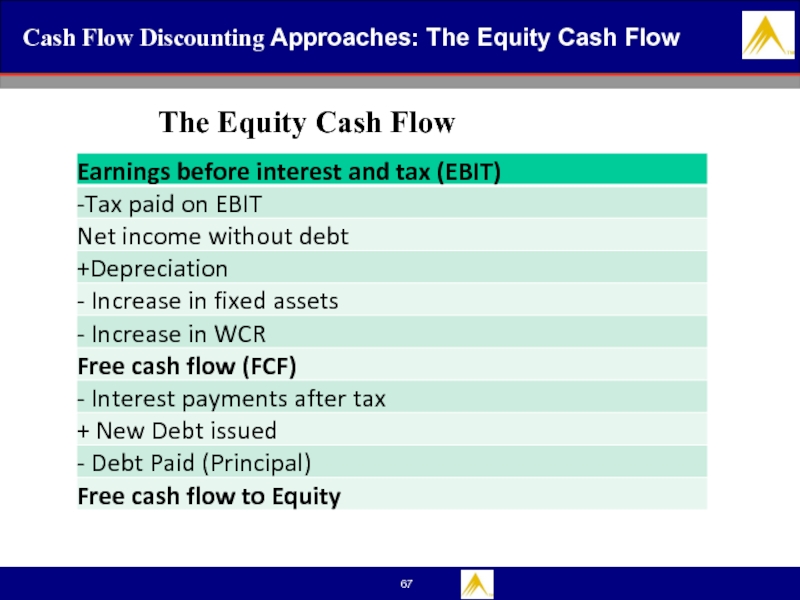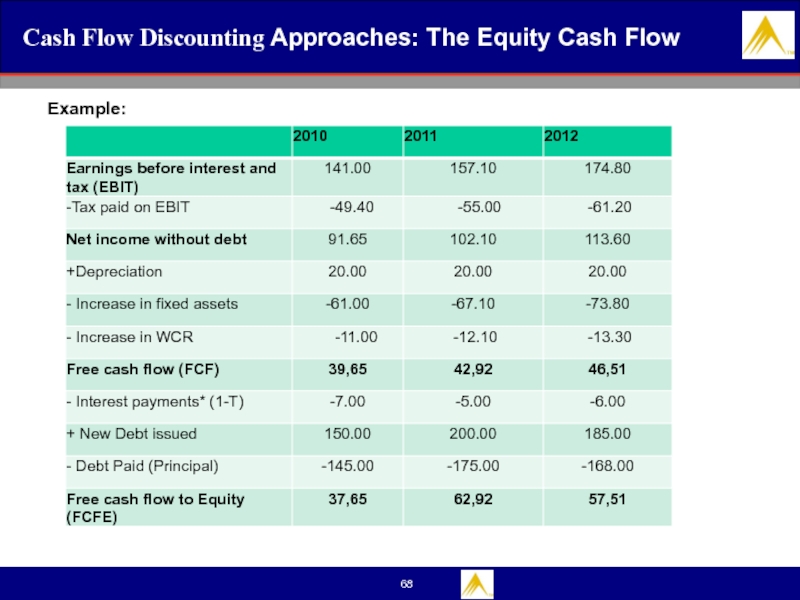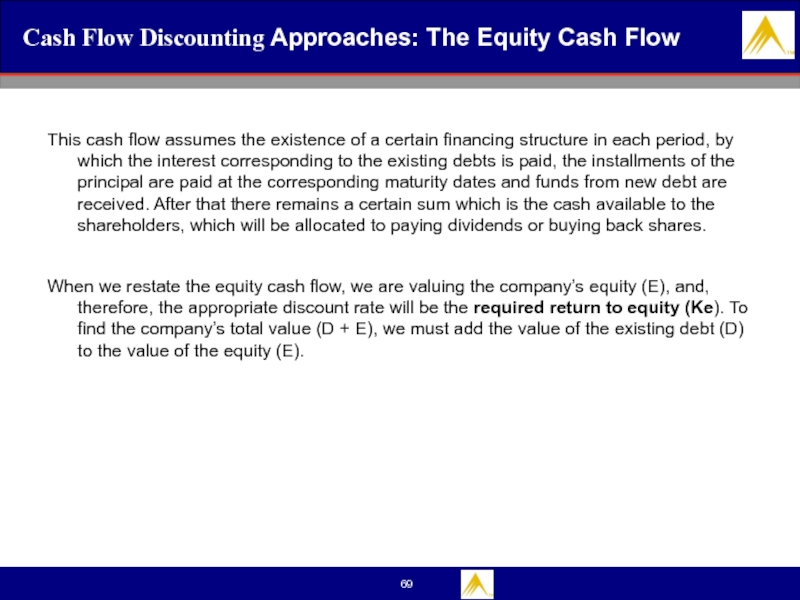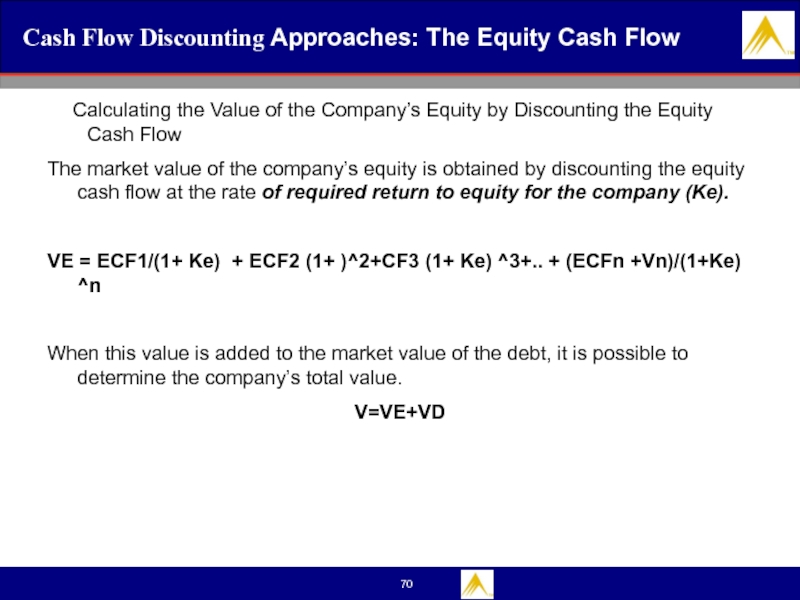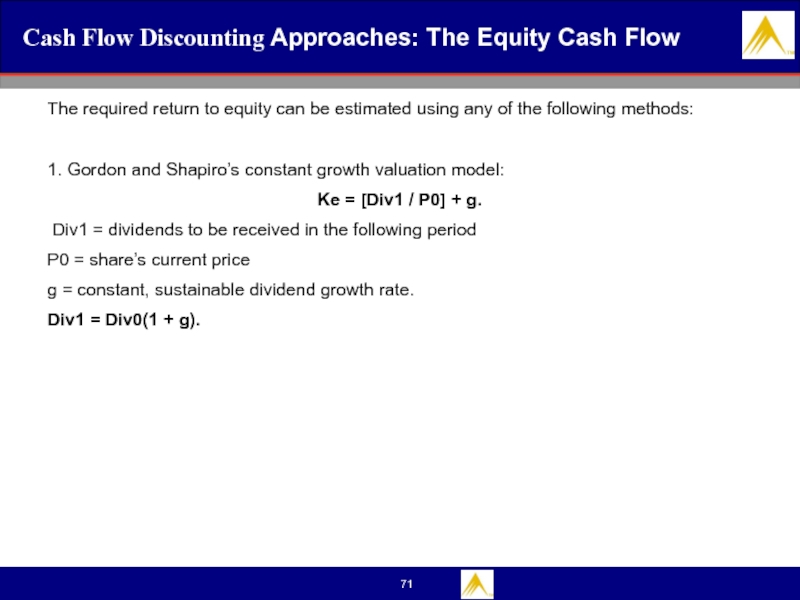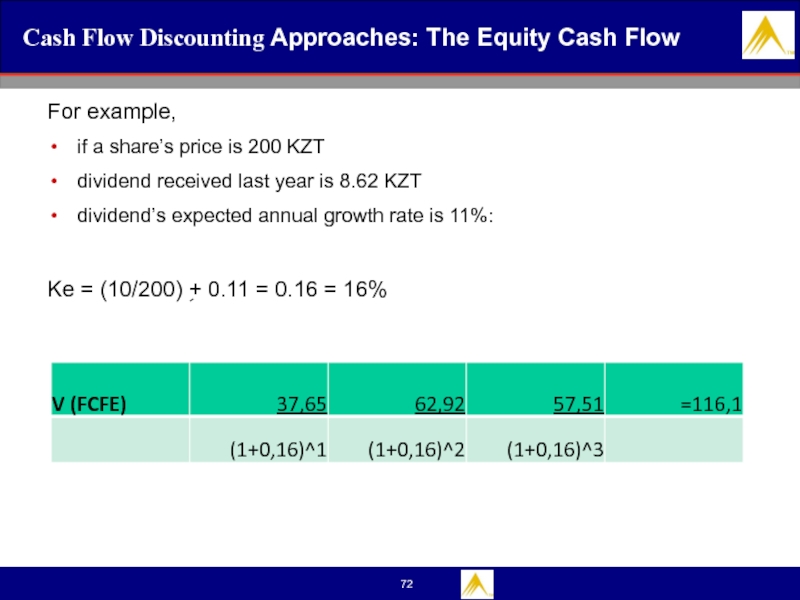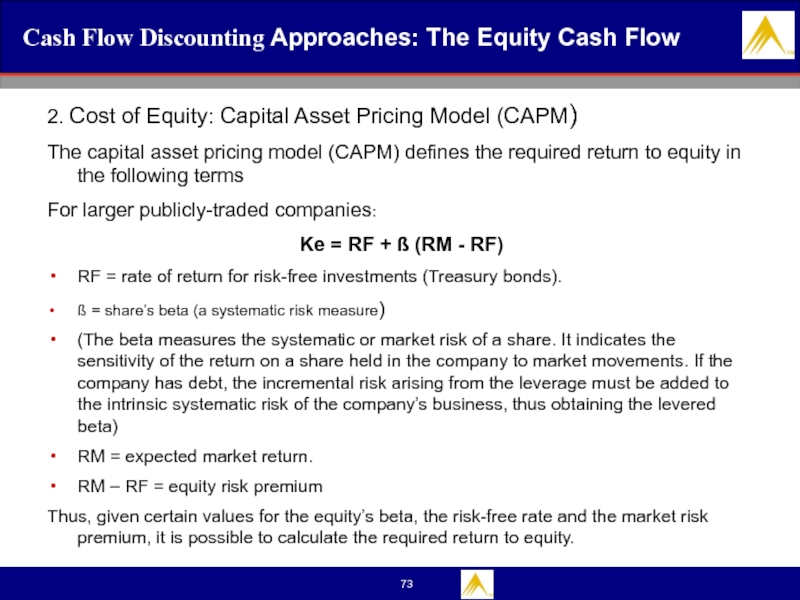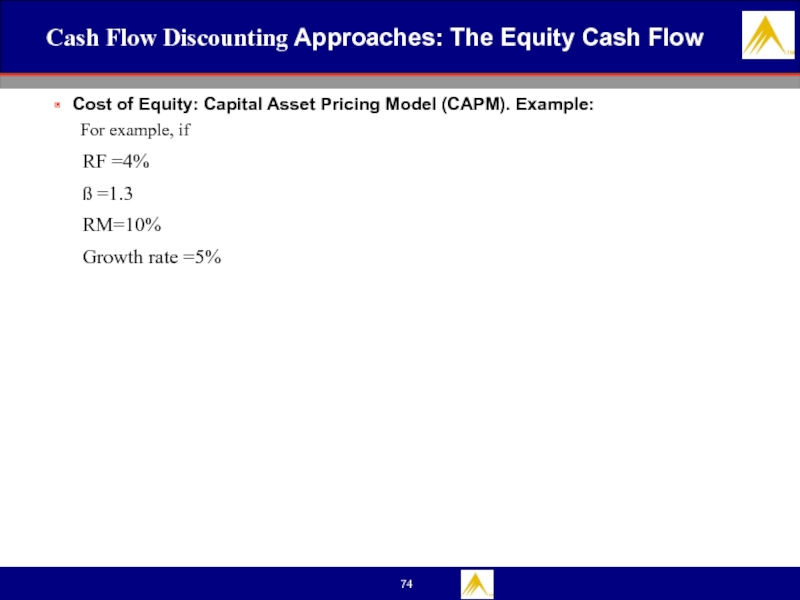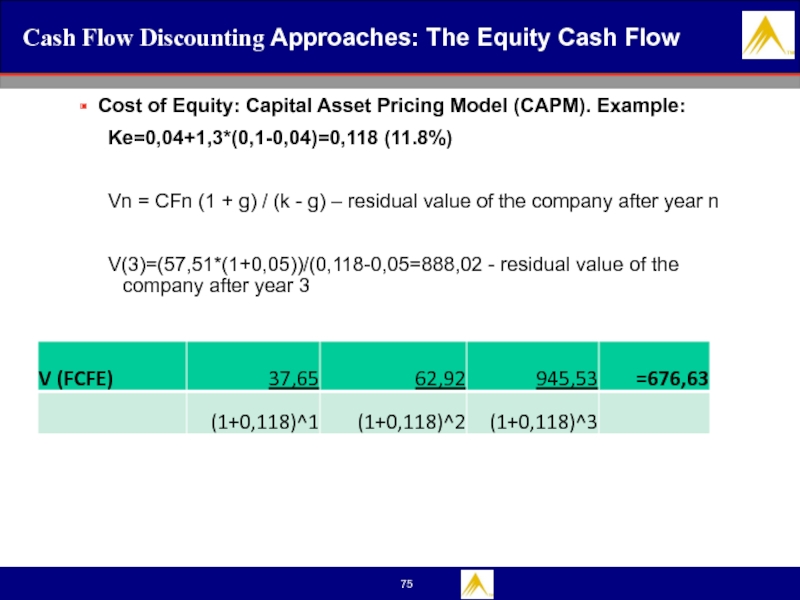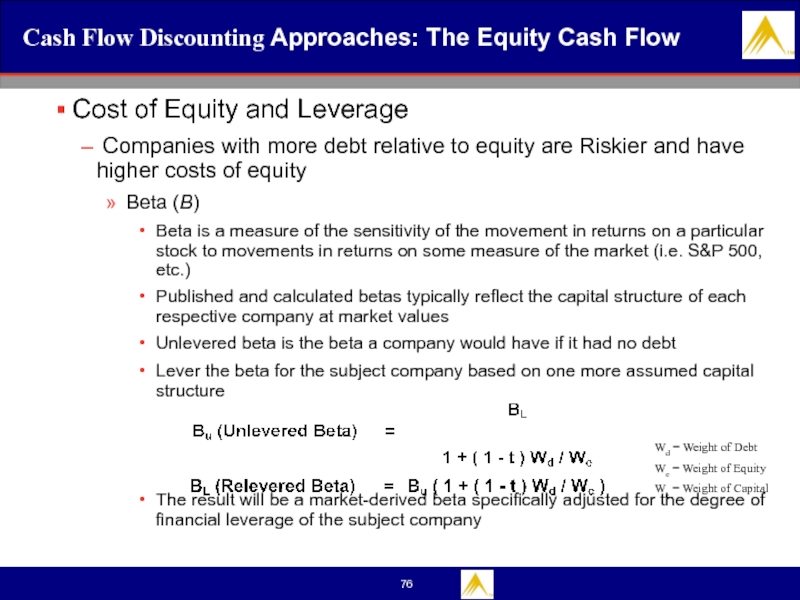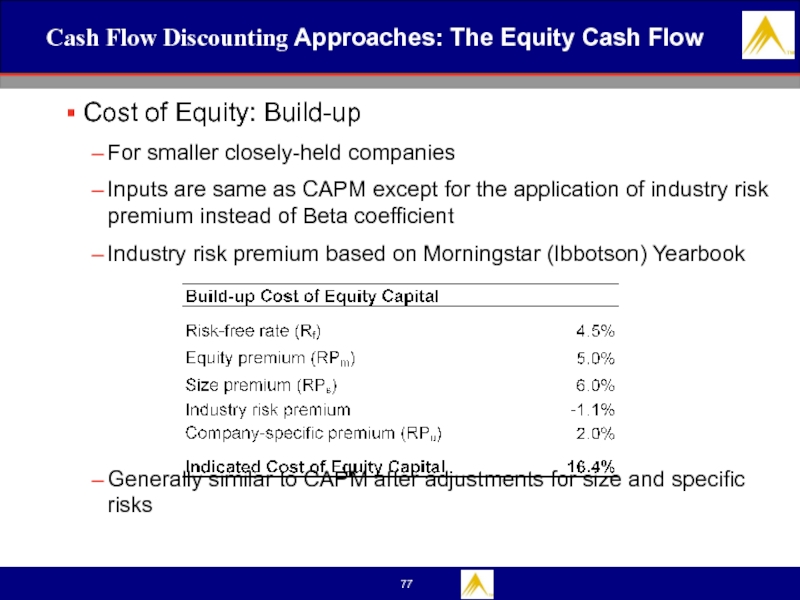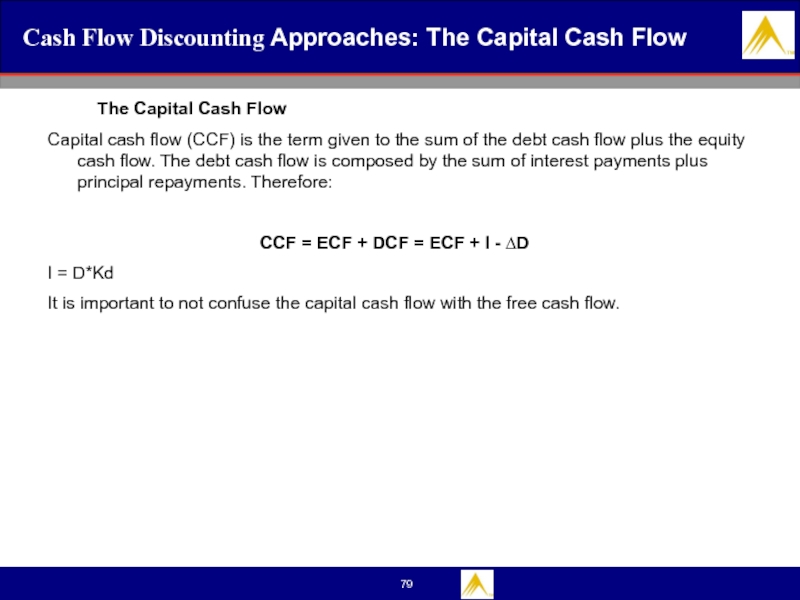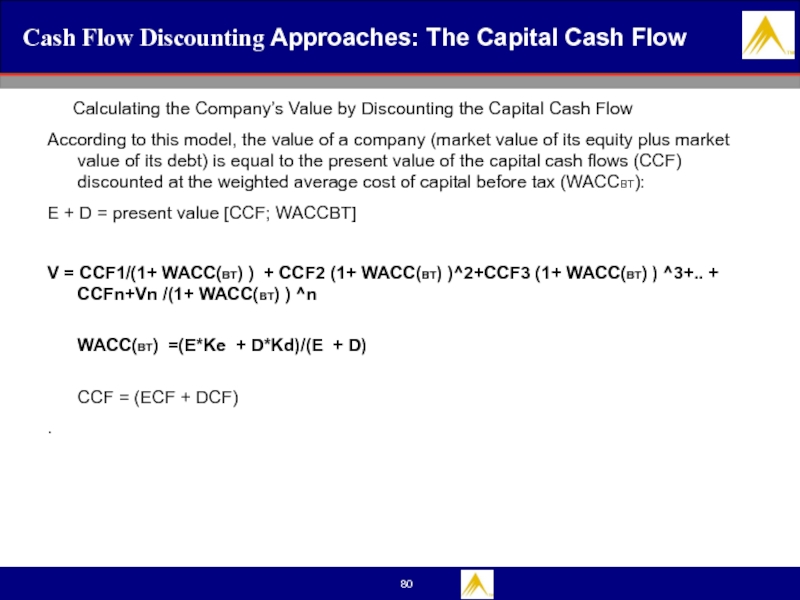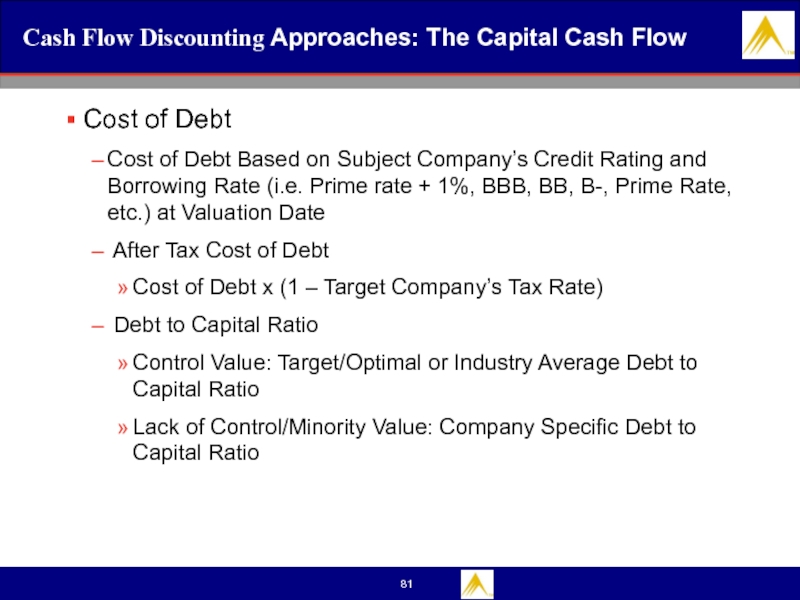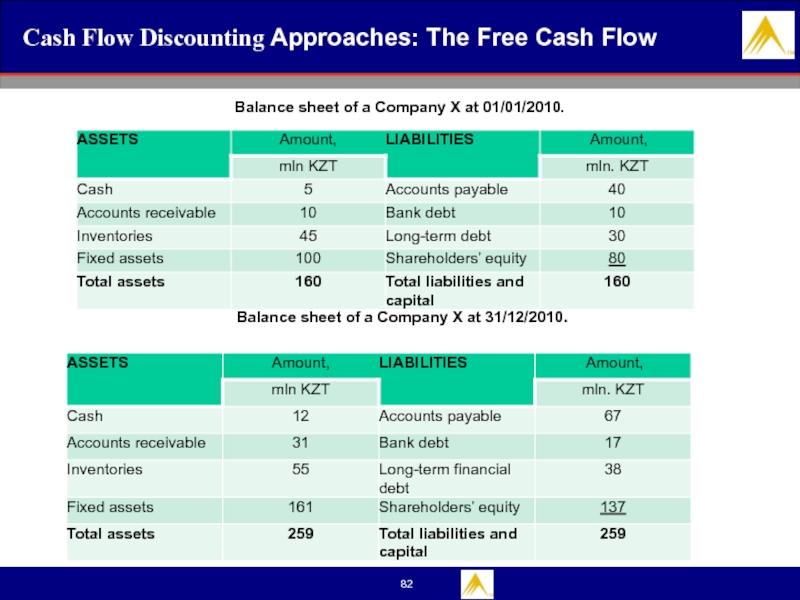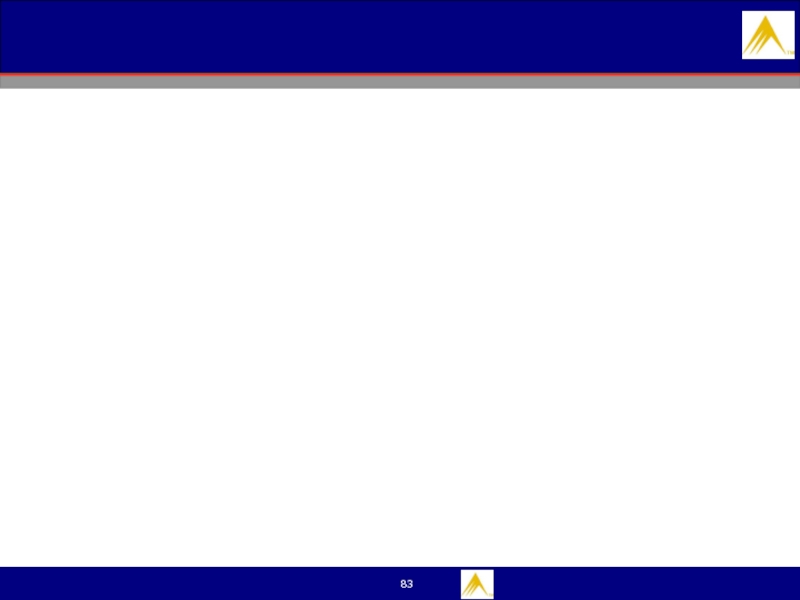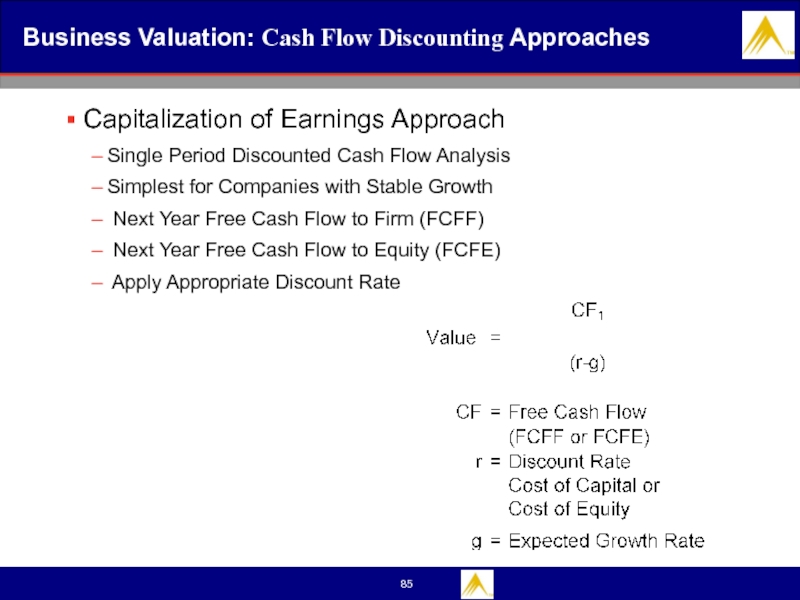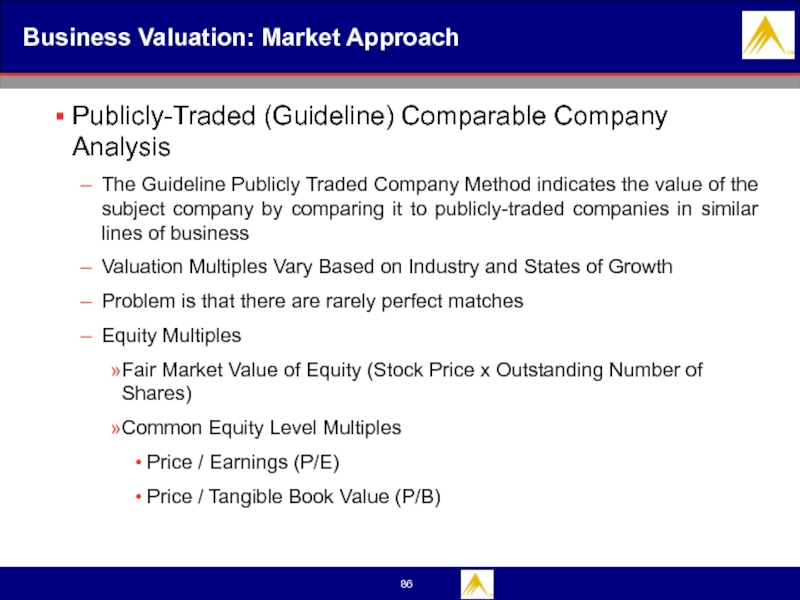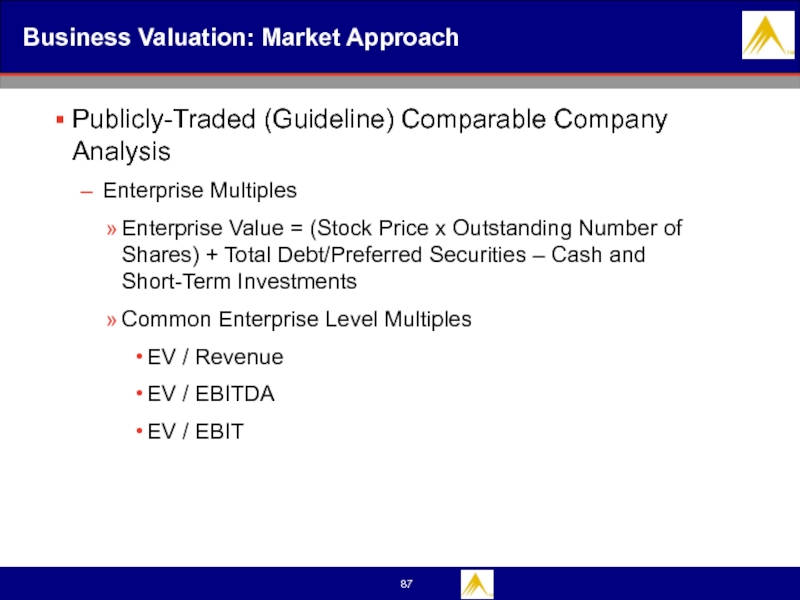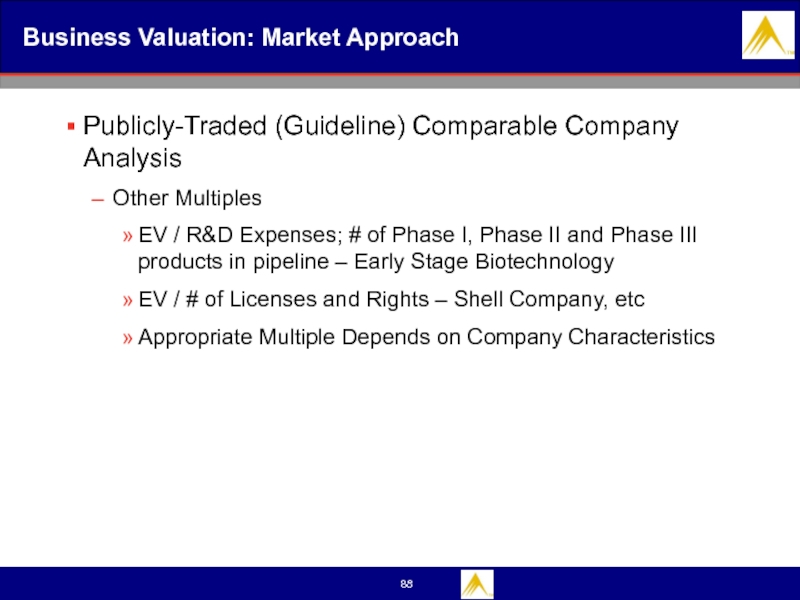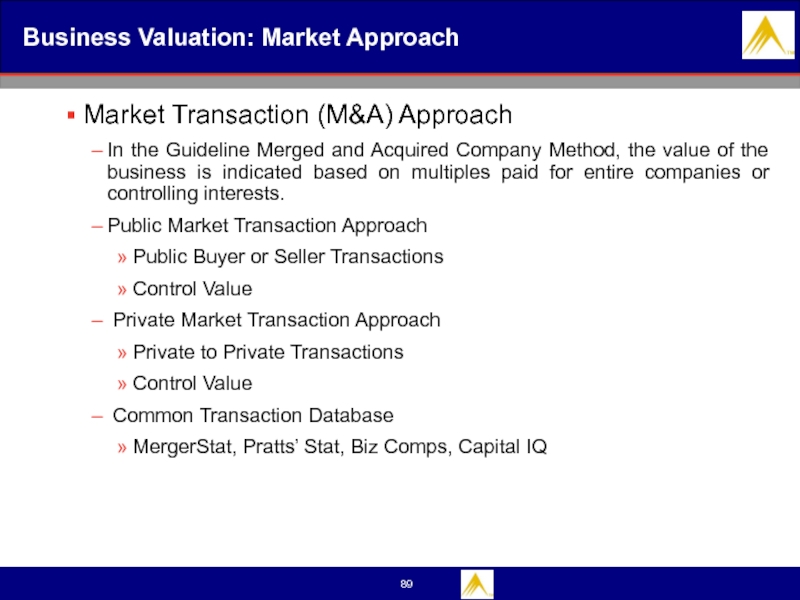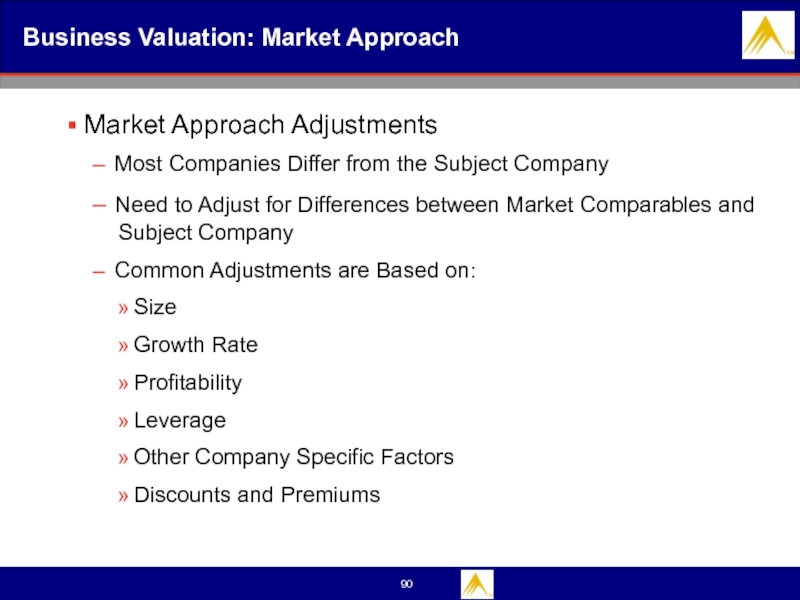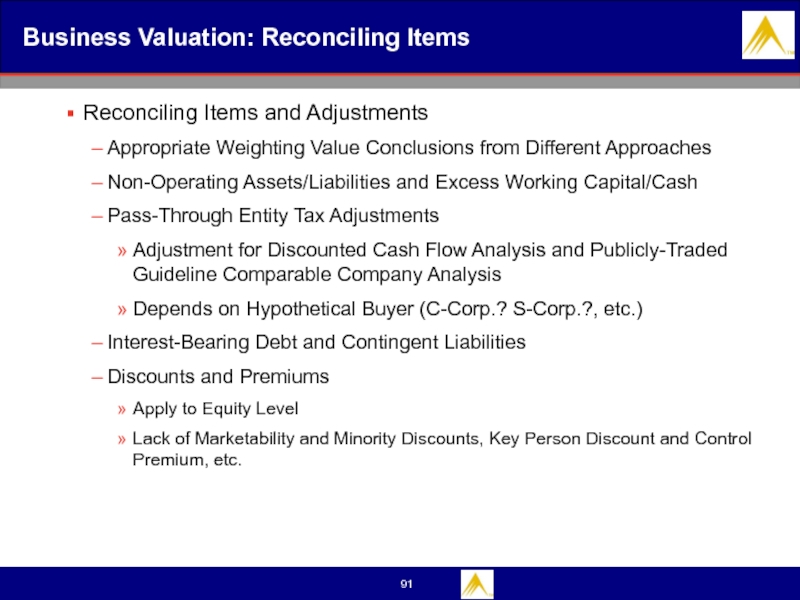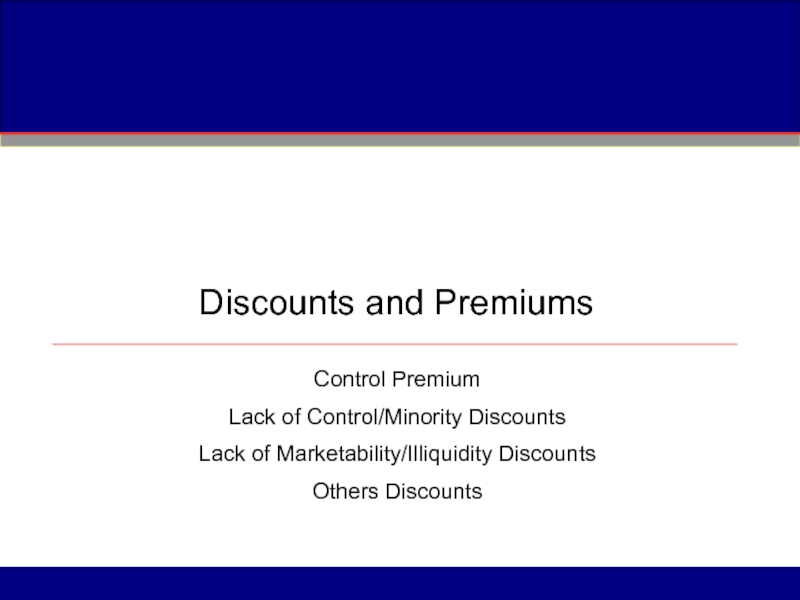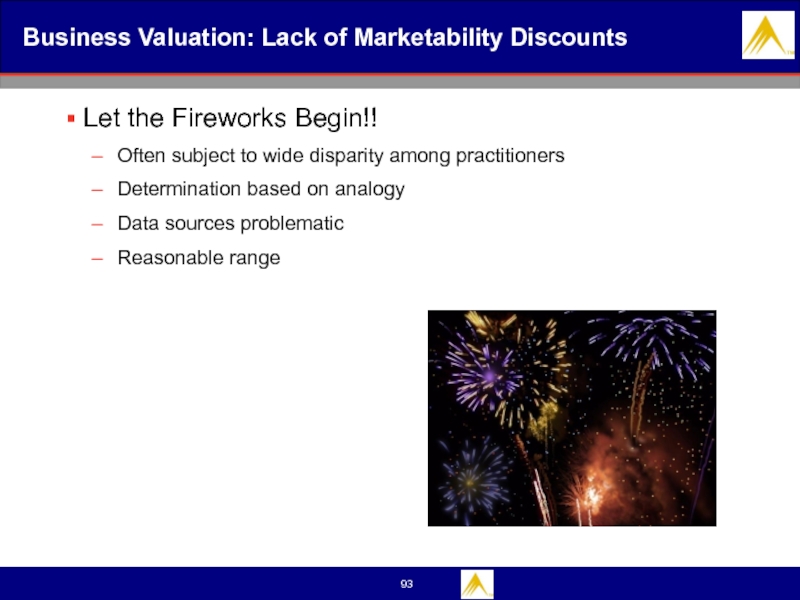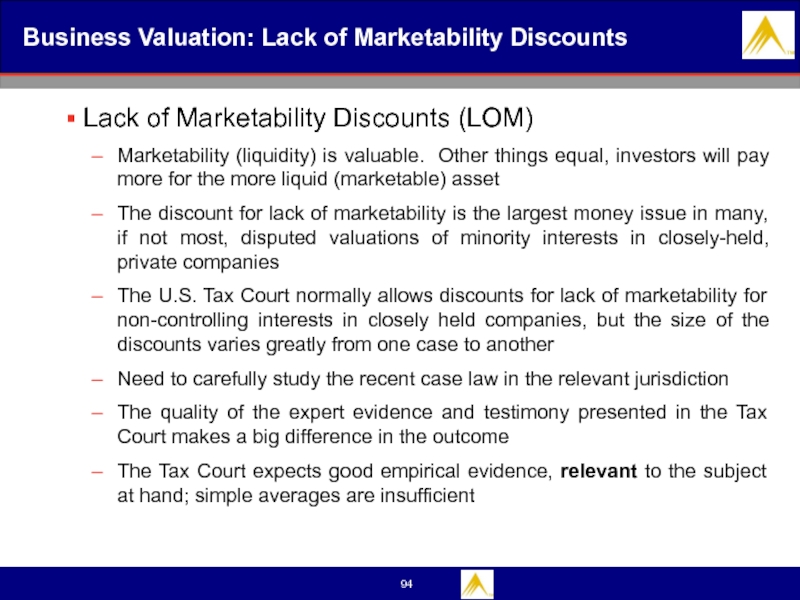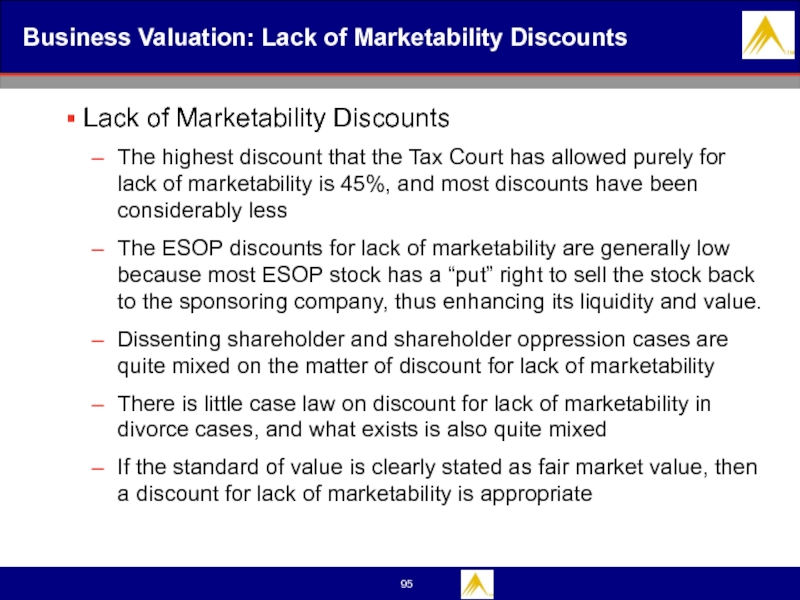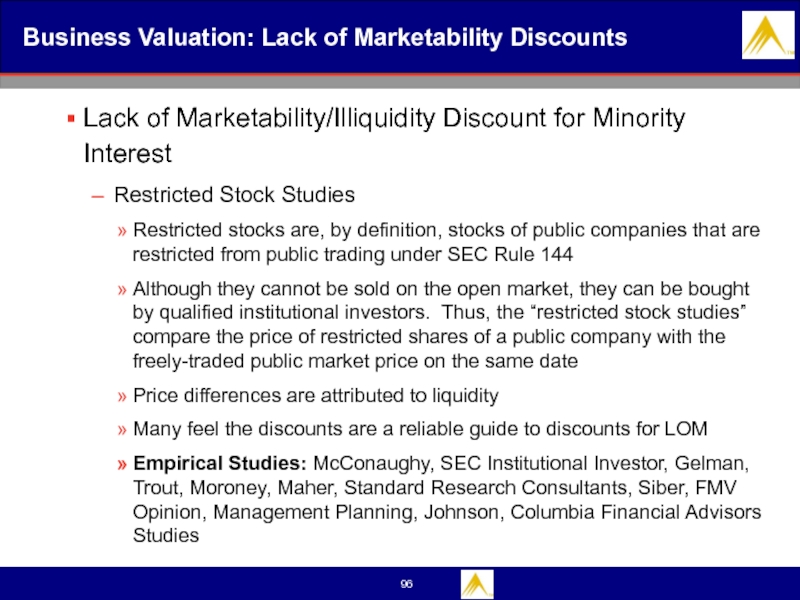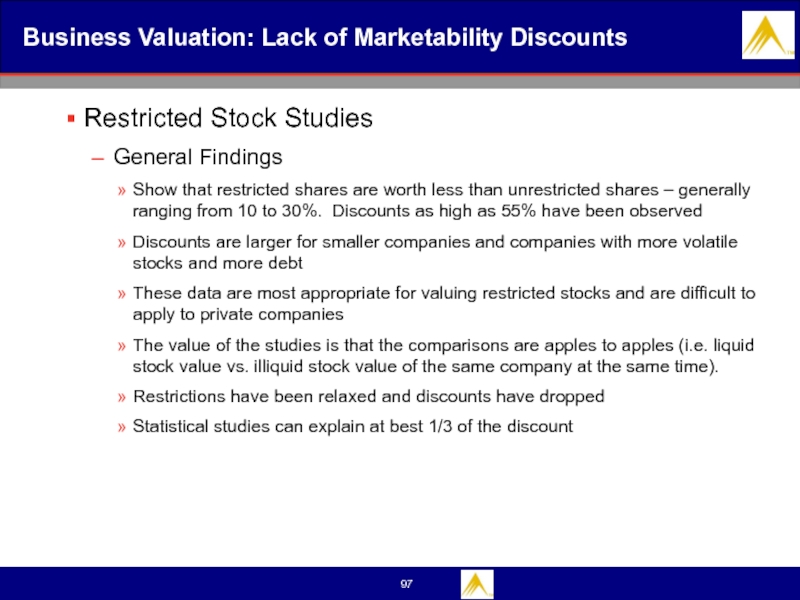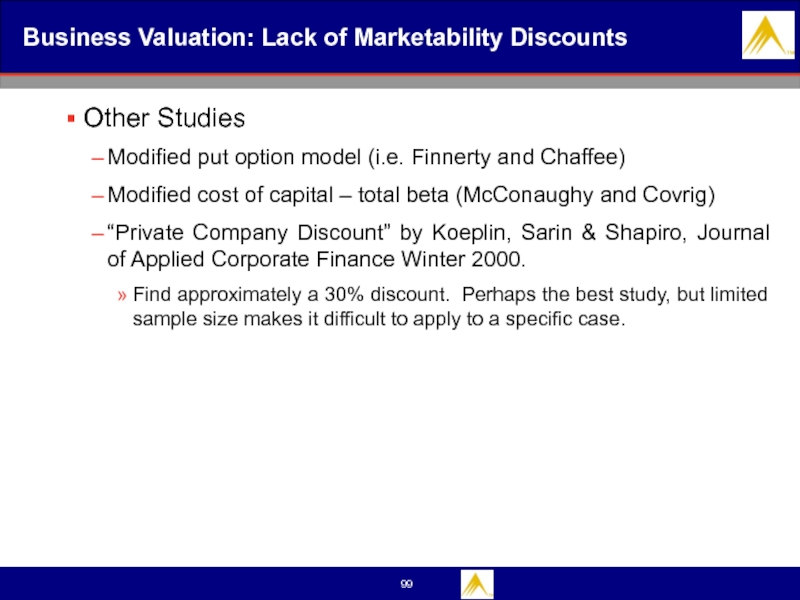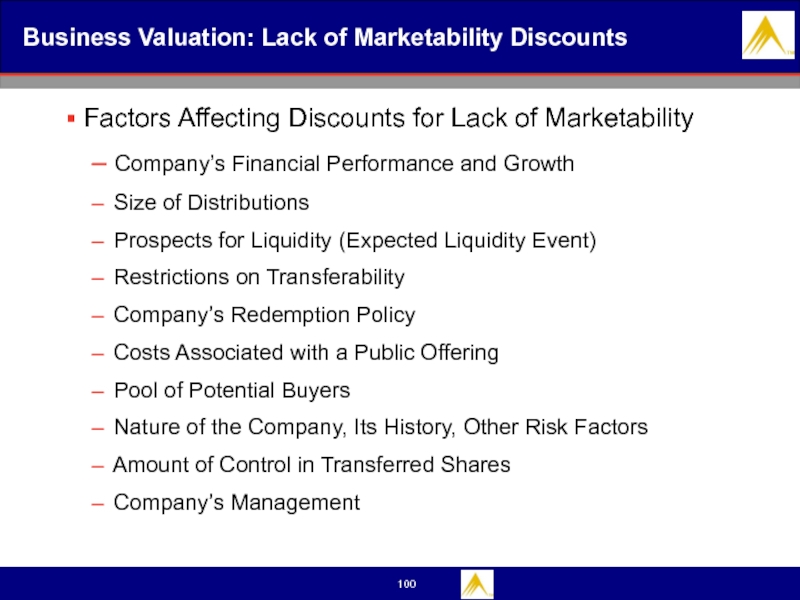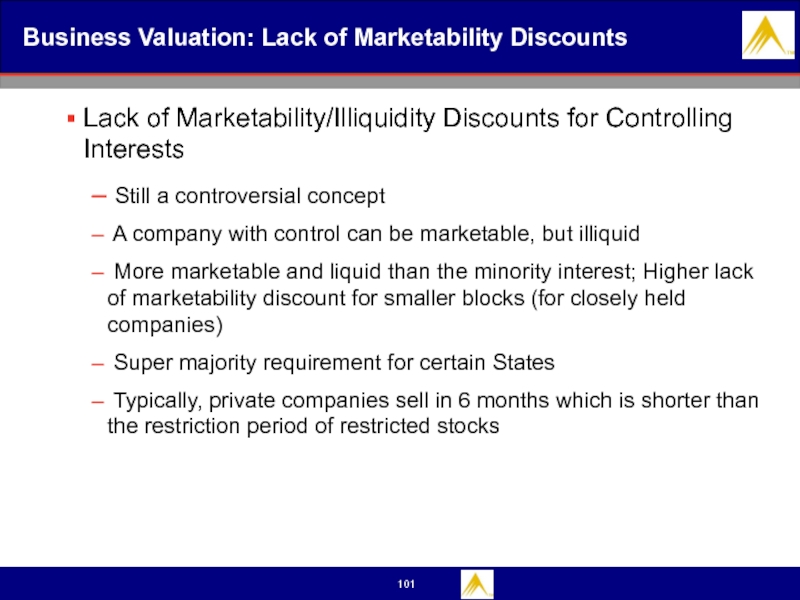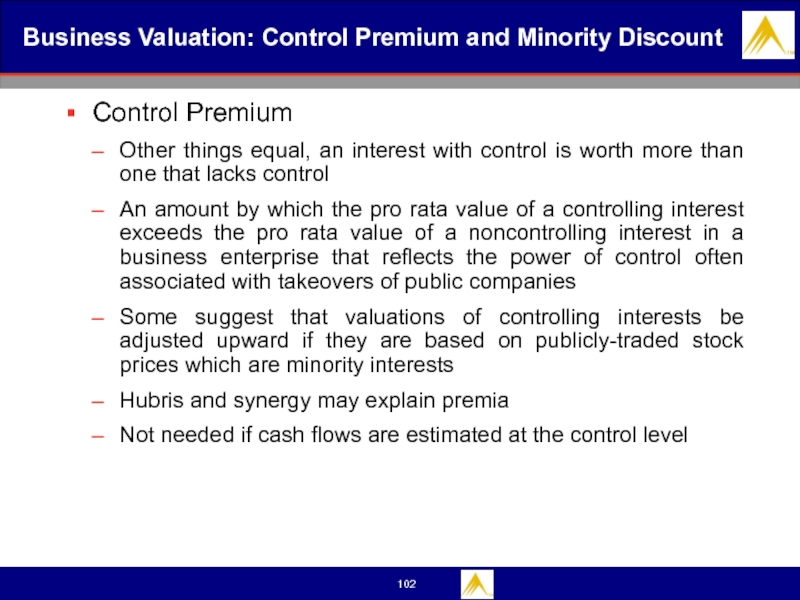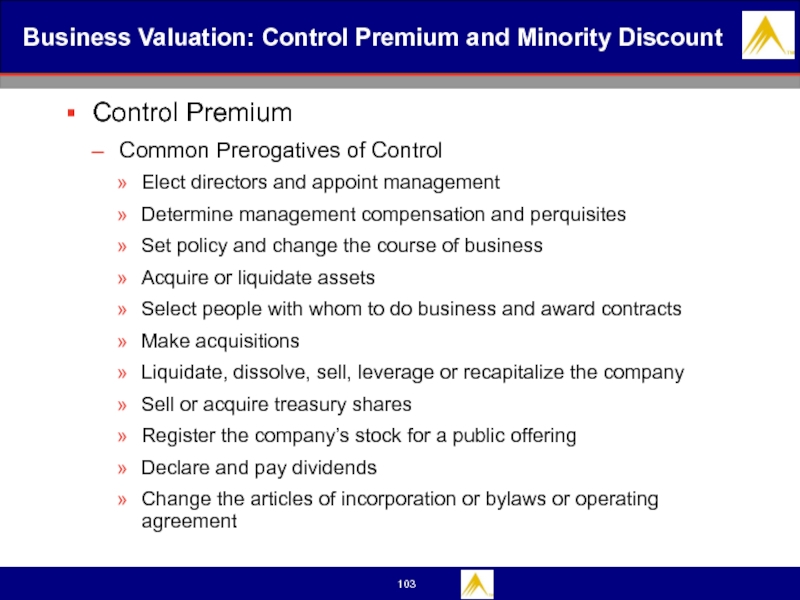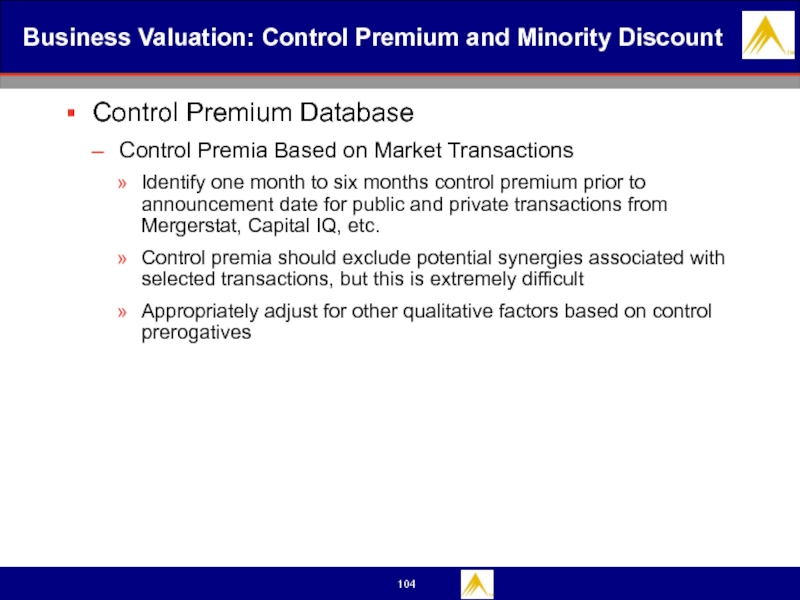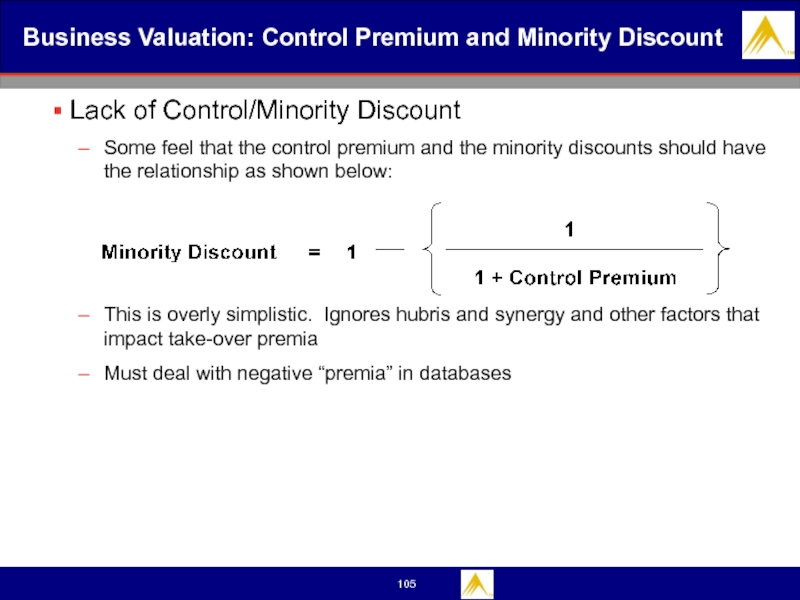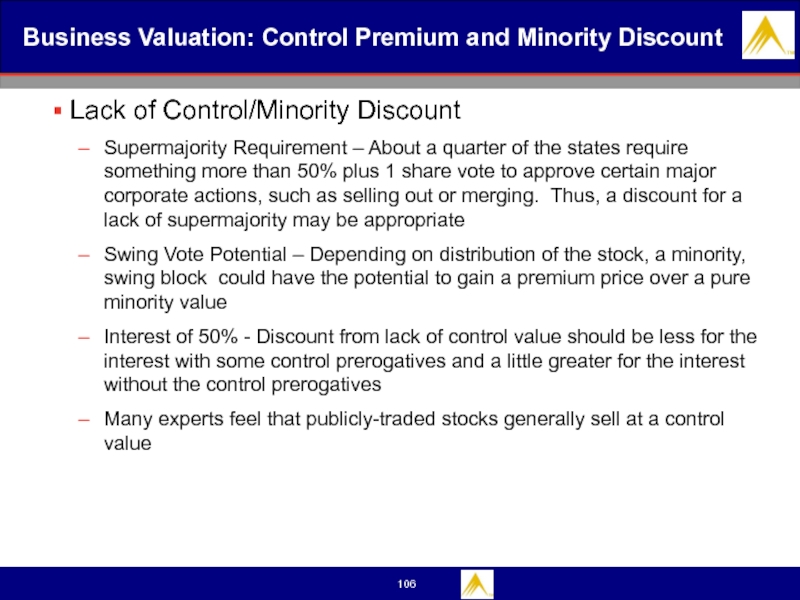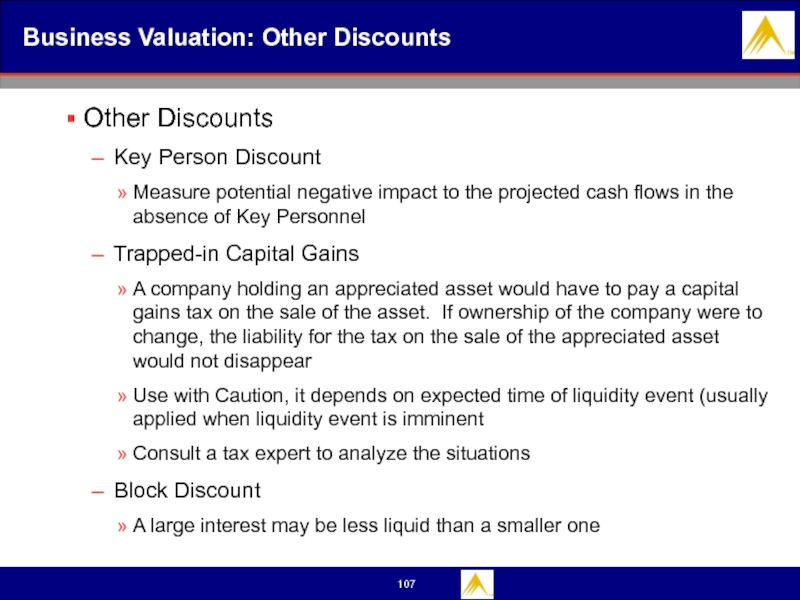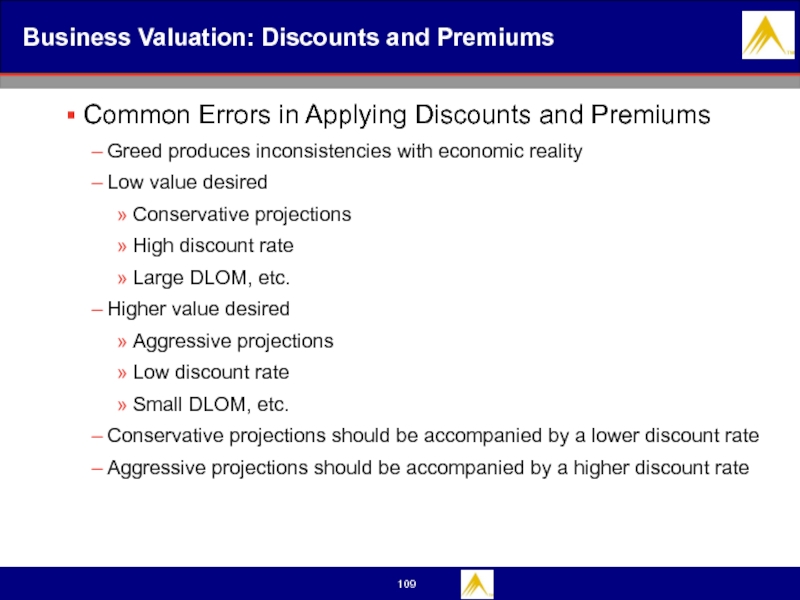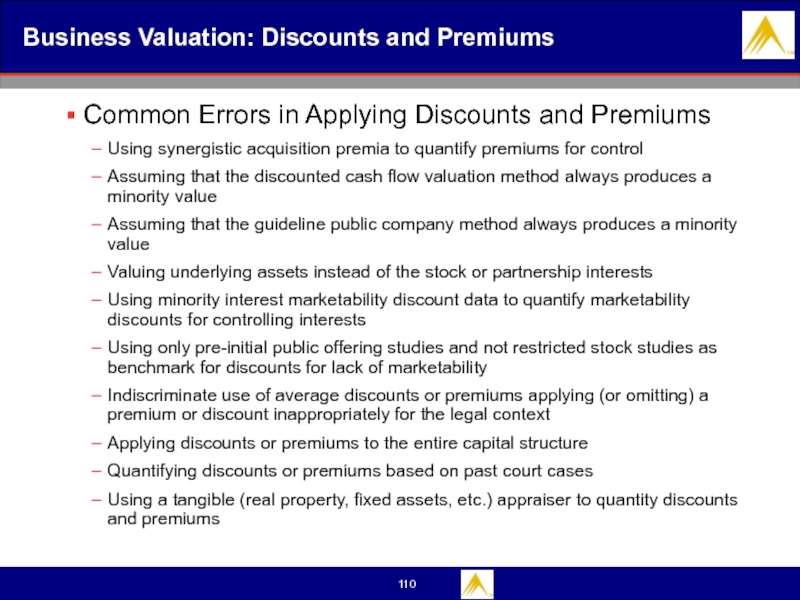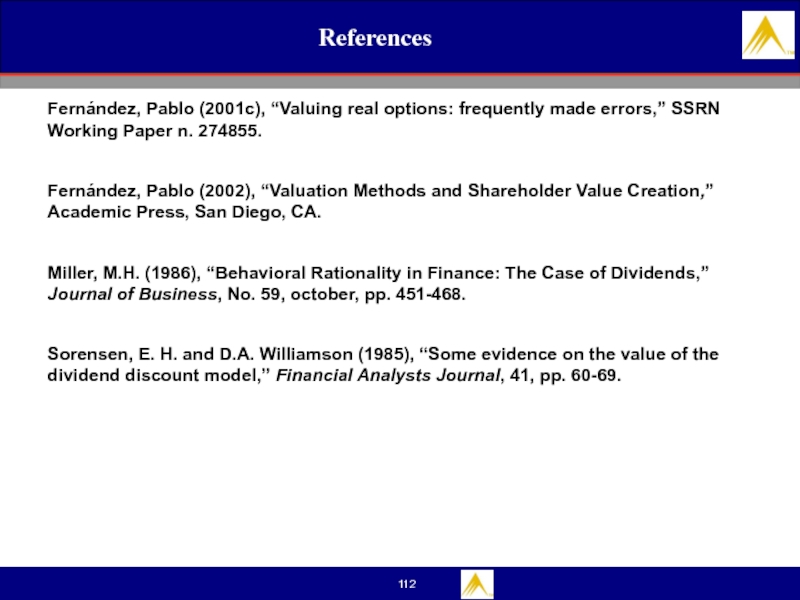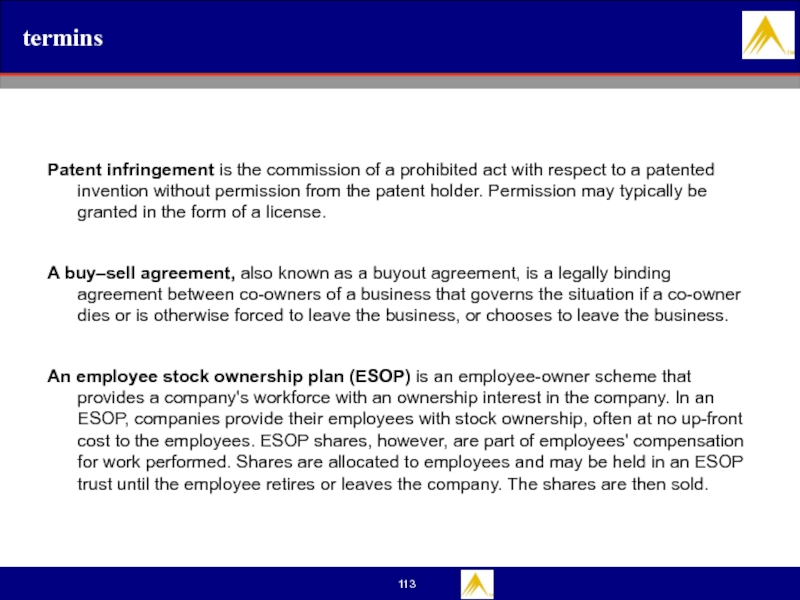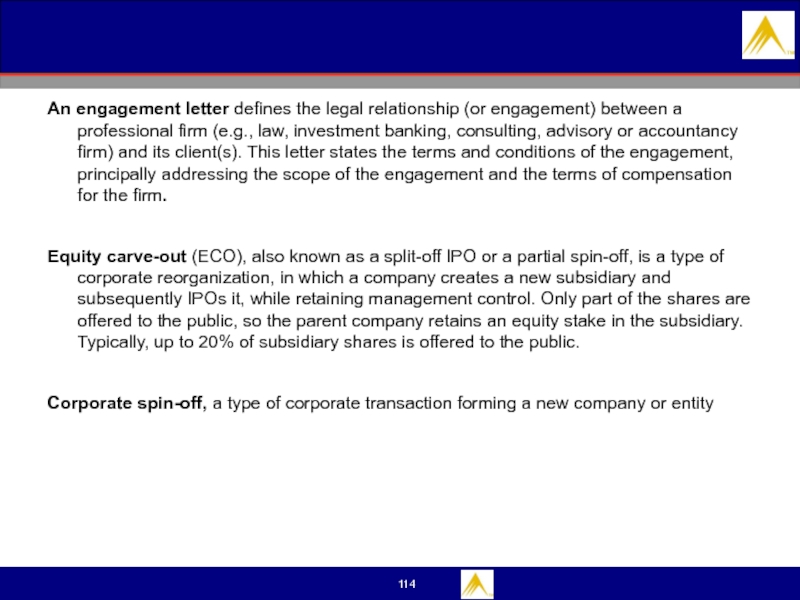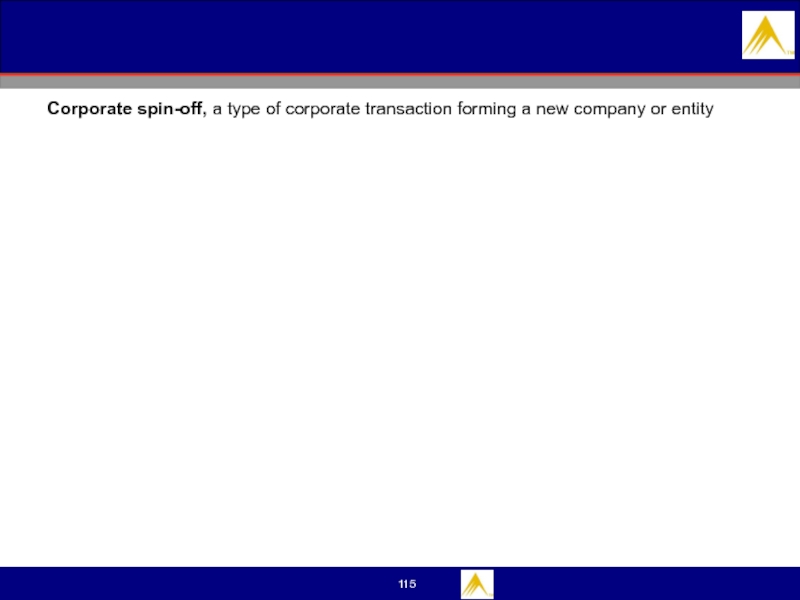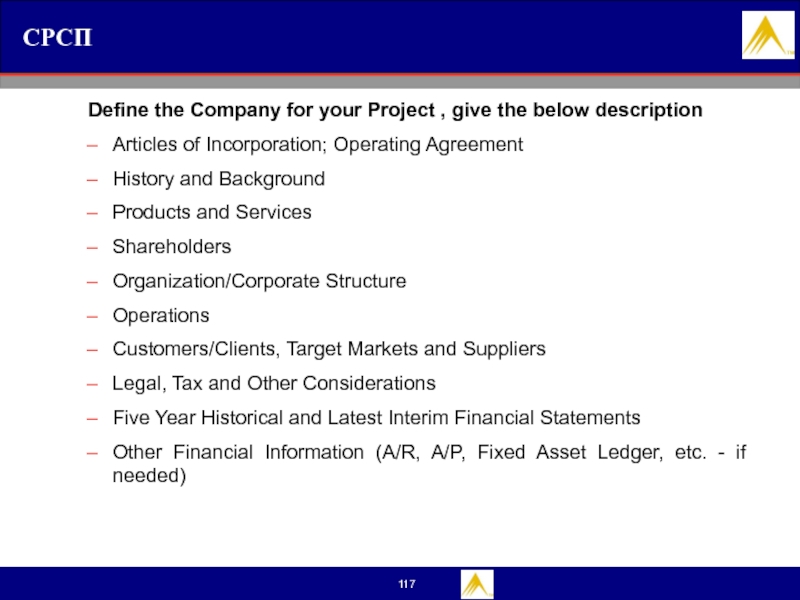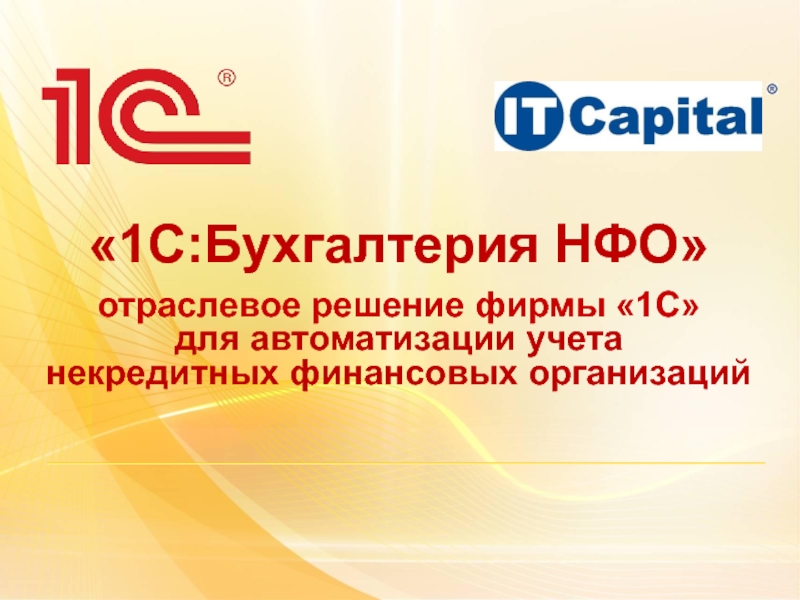- Главная
- Разное
- Дизайн
- Бизнес и предпринимательство
- Аналитика
- Образование
- Развлечения
- Красота и здоровье
- Финансы
- Государство
- Путешествия
- Спорт
- Недвижимость
- Армия
- Графика
- Культурология
- Еда и кулинария
- Лингвистика
- Английский язык
- Астрономия
- Алгебра
- Биология
- География
- Детские презентации
- Информатика
- История
- Литература
- Маркетинг
- Математика
- Медицина
- Менеджмент
- Музыка
- МХК
- Немецкий язык
- ОБЖ
- Обществознание
- Окружающий мир
- Педагогика
- Русский язык
- Технология
- Физика
- Философия
- Химия
- Шаблоны, картинки для презентаций
- Экология
- Экономика
- Юриспруденция
Financial Methods in Business Valuation презентация
Содержание
- 1. Financial Methods in Business Valuation
- 2. Outline Business Valuation Introduction Reasons for
- 3. Business Valuations “The act
- 4. What are “Business Valuations?”
- 5. Reasons for Business Valuations Sale
- 6. Business Valuation: Common Uses of Business Valuation
- 7. MAIN VALUATION METHODS
- 8. Standards of Value and Valuation Process
- 9. Business Valuation: Standard of Value Purpose
- 10. Business Valuation: Standards of Value Common Standards
- 11. Fair Value (FASB Definition) Fair
- 12. Fair Value (Legal Definition) Fair
- 13. General Valuation Objectives There is no
- 14. Misconceptions about Valuation Myth 1: A valuation
- 15. Professional Organizations: The Appraisal Foundation The Appraisal
- 16. Standards Business valuation appraisers follow the
- 17. Revenue Rulings Revenue Ruling 59-60 Outlines
- 18. RR 59-60 Factors The nature of the
- 19. National valuation standards of RK 1.
- 20. National valuation standards of RK 5. Kazakhstan
- 21. National valuation standards of RK 10. Kazakhstan
- 22. Business Valuation: Valuation Process 1.1 Proposal
- 23. Elements of a Business Valuation Packet Engagement Agreement Checklist Site Visit
- 24. Engagement Agreement Rule 201A, Professional
- 25. Engagement Agreement In determining to accept an
- 26. Engagement Agreement Other factors to be considered
- 27. Business Valuation: Analyzing Data Researching Economic and
- 28. Business Valuation: Gathering Data Gathering Company Data
- 29. Checklist A basic information checklist includes the
- 30. Checklist Appraiser should try to derive an
- 31. Valuation Methodologies
- 32. Balance Sheet-Based Methods (Shareholders’ Equity)
- 33. Balance Sheet-Based Method on the basis of
- 34. Balance Sheet-Based Method on the basis
- 35. Book Value and Market Value Figure
- 36. Adjusted Book Value The adjusted balance
- 37. Liquidation Value This is the company’s
- 38. Substantial Value The substantial value represents
- 39. Income Statement-Based Methods Income Statement-Based Methods
- 40. Value of Earnings According to this
- 41. Sometimes, the relative PER is also
- 42. Value of the Dividends Dividends are
- 43. Business Valuation: Weighted Average Cost of Capital
- 44. Sales Multiples This valuation method, which
- 45. Other Multiples In addition to the
- 47. Business Valuation: Cash Flow Discounting Approaches
- 48. Business Valuation: Cash Flow Discounting Approaches
- 49. Business Valuation: Cash Flow Discounting Approaches
- 50. Business Valuation: Cash Flow Discounting Approaches
- 51. Business Valuation: Cash Flow Discounting Approaches Although
- 52. Business Valuation: Cash Flow Discounting Approaches The
- 53. Business Valuation: Cash Flow Discounting Approaches For
- 54. Business Valuation: Cash Flow Discounting Approaches Main
- 55. Cash Flow Discounting Approaches: discount rates
- 56. Cash Flow Discounting Approaches: The Free Cash
- 57. Cash Flow Discounting Approaches: The Free Cash
- 58. Cash Flow Discounting Approaches: The Free Cash
- 59. Cash Flow Discounting Approaches: The Free Cash
- 60. Cash Flow Discounting Approaches: The Free Cash
- 61. Cash Flow Discounting Approaches: The Free Cash
- 62. Cash Flow Discounting Approaches: The Free Cash
- 63. Cash Flow Discounting Approaches: The Free Cash
- 64. Cash Flow Discounting Approaches: The Free Cash
- 65. Cash Flow Discounting Approaches The Free Cash Flow
- 66. Cash Flow Discounting Approaches: The Equity Cash
- 67. Cash Flow Discounting Approaches: The Equity Cash Flow The Equity Cash Flow
- 68. Cash Flow Discounting Approaches: The Equity Cash Flow Example:
- 69. Cash Flow Discounting Approaches: The Equity Cash
- 70. Cash Flow Discounting Approaches: The Equity Cash
- 71. Cash Flow Discounting Approaches: The Equity Cash
- 72. Cash Flow Discounting Approaches: The Equity Cash
- 73. Cash Flow Discounting Approaches: The Equity Cash
- 74. Cash Flow Discounting Approaches: The Equity Cash
- 75. Cash Flow Discounting Approaches: The Equity Cash
- 76. Cash Flow Discounting Approaches: The Equity Cash
- 77. Cash Flow Discounting Approaches: The Equity Cash
- 78. Cash Flow Discounting Approaches The Capital Cash Flow
- 79. Cash Flow Discounting Approaches: The Capital Cash
- 80. Cash Flow Discounting Approaches: The Capital Cash
- 81. Cash Flow Discounting Approaches: The Capital Cash
- 82. Cash Flow Discounting Approaches: The Free Cash
- 84. Business Valuation: Cash Flow Discounting Approaches
- 85. Business Valuation: Cash Flow Discounting Approaches
- 86. Business Valuation: Market Approach Publicly-Traded
- 87. Business Valuation: Market Approach Publicly-Traded
- 88. Business Valuation: Market Approach Publicly-Traded
- 89. Business Valuation: Market Approach Market
- 90. Business Valuation: Market Approach Market
- 91. Business Valuation: Reconciling Items Reconciling Items and
- 92. Discounts and Premiums Control
- 93. Business Valuation: Lack of Marketability Discounts Let
- 94. Business Valuation: Lack of Marketability Discounts Lack
- 95. Business Valuation: Lack of Marketability Discounts Lack
- 96. Business Valuation: Lack of Marketability Discounts Lack
- 97. Business Valuation: Lack of Marketability Discounts Restricted
- 98. Business Valuation: Lack of Marketability Discounts Pre-IPO
- 99. Business Valuation: Lack of Marketability Discounts Other
- 100. Business Valuation: Lack of Marketability Discounts Factors
- 101. Business Valuation: Lack of Marketability Discounts Lack
- 102. Business Valuation: Control Premium and Minority Discount
- 103. Business Valuation: Control Premium and Minority Discount
- 104. Business Valuation: Control Premium and Minority Discount
- 105. Business Valuation: Control Premium and Minority Discount
- 106. Business Valuation: Control Premium and Minority Discount
- 107. Business Valuation: Other Discounts Other Discounts
- 108. Business Valuation: Other Discounts Other Discounts Voting
- 109. Business Valuation: Discounts and Premiums Common Errors
- 110. Business Valuation: Discounts and Premiums Common Errors
- 111. References Brealey, R.A. and S.C. Myers (2000),
- 112. References Fernández, Pablo (2001c), “Valuing real options:
- 113. termins Patent infringement is the
- 114. An engagement letter defines the legal
- 115. Corporate spin-off, a type of corporate transaction forming a new company or entity
- 116. Everything You Should Know Understand the
- 117. СРСП Define the Company for your
Слайд 2Outline
Business Valuation Introduction
Reasons for a Business Valuation
Valuation Process and Standards of
Valuation Methodology
Methods of Corporate Valuation
Private Company Valuation
Discounts and Premiums
Слайд 3Business Valuations
“The act or process of determining the value of a
*International Glossary of Business Valuation.
*IRS Business Valuation Guideline 2006
Слайд 4
What are “Business Valuations?”
ASSET APPRAISAL
Real Estate
Machinery & Equipment
Intangible Assets
BUSINESS VALUATION
Complete Business
Слайд 5Reasons for Business Valuations
Sale of business or part interest
Ownership Disputes
Financing
Buy-Sell Agreements
Employee
Condemnation
Divorce
Estate Planning
Change of Business Structure
Recapitalization
Life Insurance
Слайд 6Business Valuation: Common Uses of Business Valuation
Tax
Estate/Gifts
Buy/Sell Agreements
Bankruptcy and Litigation
Liquidation or Reorganization
Patent Infringement
Partner Disputes
Economic Damages
Financial Reporting
Purchase Price Allocation, Impairment Testing and Stock Options and Grants, etc.
Strategic Planning/Transaction
Value Enhancement
Business Plan/Capital Raising
Strategic Direction, Spin-Offs, Carve Outs, etc.
Acquisitions, Due Diligence
Employee Stock Ownership Plan (ESOP)
Internal Revenue Codes (IRC)
Solvency and Fairness Opinions
Damage Assessment
Dissenting Shareholder Actions
Dissolutions
Слайд 9Business Valuation: Standard of Value
Purpose
Establish Purpose of the Engagement
Estate/Gift,
Standards of Value (i.e. Fair Market Value, Fair Value, etc.)
Interest Being Valued (i.e. Enterprise, Equity, Marketable, Non-Marketable, Control, Minority, etc.)
Valuation Date
Agree on a Appropriate Valuation Date
Utilize Data Subsequent to the Valuation Date
Sometimes can Consider Data After the Valuation Date if it was Foreseeable as of the Valuation Date
Слайд 10Business Valuation: Standards of Value
Common Standards of Value
Fair Market Value (Tax):
“The fair market value is the price at which the property would change hands between a willing buyer and a willing seller, neither being under any compulsion to buy or to sell and both having reasonable knowledge of relevant facts.” – IRS Revenue Ruling 59-60
Liquidation Value: Orderly; forced.
Fair Value (Financial Reporting): Can vary but it is generally similar to Fair market value with some exceptions.
The amount at which an asset (or liability) could be bought (or incurred) or sold (or settled) in a current transaction between willing parties, that is, other than in a forced or liquidation sale.”-FASB (Financial Accounting Standards Board) 157
Fair Value (Litigation): Fair value may be the applicable standard of value in a number of different situations, including shareholder dissent and oppression matters, corporate dissolution and divorce.
Слайд 11Fair Value (FASB Definition)
Fair Value – is defined in this subtopic
Слайд 12Fair Value (Legal Definition)
Fair Value- is often used in court cases
Слайд 13General Valuation Objectives
There is no one right way to value an
Business appraisers strive to achieve results that meet certain general requirements.
Consistency Ideally, different skilled appraisers should produce a similar valuation for a given asset.
Defensibility There is always the general possibility that any valuation could be subjected to legal challenges.
Suitability for purpose Valuations must be suitable to the purposes and circumstances of the individuals needing the information.
Слайд 14Misconceptions about Valuation
Myth 1: A valuation is an objective search for
Truth 1.1: All valuations are biased. The only questions are how much and in which direction.
Truth 1.2: The direction and magnitude of the bias in your valuation is directly proportional to who pays you.
Myth 2.: A good valuation provides a precise estimate of value
Truth 2.1: There are no precise valuations
Truth 2.2: The payoff to valuation is greatest when valuation is least precise.
Myth 3: . The more quantitative a model, the better the valuation
Truth 3.1: One’s understanding of a valuation model is inversely proportional to the number of inputs required for the model.
Truth 3.2: Simpler valuation models do much better than complex ones.
Слайд 15Professional Organizations: The Appraisal Foundation
The Appraisal Foundation comprises two independent boards.
Standards and standards rules For example, Standard 10 deals with business appraisal reporting.
Statements on appraisal standards For example, Statement on Appraisal Standard 2 deals with discounted cash flow analysis.
Advisory opinions These opinions relate to specific subjects. For example, Advisory Opinion 10 deals with the appraiser-client relationship.
Слайд 16Standards
Business valuation appraisers follow the following standards and guidelines:
American Institute of
The Appraisal Foundation’s Uniform Standards of Professional Appraisal Practice (“USPAP”);
The ethics and standards of the American Society of Appraisers; and
The Internal Revenue Service’s business valuation development and reporting guidelines.
Слайд 17Revenue Rulings
Revenue Ruling 59-60
Outlines the approaches, methods, and factors to be
Revenue Ruling 65-192
Extended the concepts in Revenue Ruling 59-60 to income and other tax purposes as well as to business interests of any type.
Слайд 18RR 59-60 Factors
The nature of the business and its history since
The economic outlook in general and the condition and outlook of the specific industry in particular
The book value of the stock and the financial condition of the business
The earning capacity of the company
The dividend paying capacity
Whether or not the enterprise has goodwill or other intangible value
Sales of stock and the size of the block of stock to be valued
The market price of stocks of corporations engaged in the same or in a similar line of business having their stocks actively traded in a free and open market, either on an exchange or over- the-counter
Слайд 19National valuation standards of RK
1. Kazakhstan valuation Standard "Valuation of assets
(Стандарт оценки "Оценка имущества, приобретаемого и отчуждаемого государством по отдельным основаниям")
2. Kazakhstan valuation Standard "Defining the cadastral value of real estate"
(Стандарт оценки Республики Казахстан "Определение кадастровой стоимости объектов недвижимости")
3. Kazakhstan valuation Standard of "Determination of fair value in accordance with IFRS"
(Стандарт оценки Республики Казахстан "Определение справедливой стоимости в соответствии с МСФО")
4. Kazakhstan valuation Standard "Valuation for lending purpose"
(Стандарт оценки Республики Казахстан "Оценка для целей кредитования" )
Слайд 20National valuation standards of RK
5. Kazakhstan valuation Standard "Valuation of Intellectual
(Стандарт оценки Республики Казахстан "Оценка стоимости объектов интеллектуальной собственности и нематериальных активов")
6. Kazakhstan valuation Standard "Databases and the types of value"
(Стандарт оценки Республики Казахстан "Базы и типы стоимости" )
7. Kazakhstan valuation Standard "Valuation of Report reliability"
(Стандарт оценки "Проверка достоверности отчета")
8. Kazakhstan valuation Standard "Business Valuation"
(Стандарт оценки "Оценка стоимости бизнеса")
9. Kazakhstan valuation Standard "Requirements for the form and content of the valuation report"
(Стандарт оценки Республики Казахстан "Требования к содержанию и форме отчета об оценке")
Слайд 21National valuation standards of RK
10. Kazakhstan valuation Standard "Valuation of movable
(Стандарт оценки Республики Казахстан "Оценка стоимости движимого имущества")
11. Kazakhstan valuation Standard “Valuation of real estate’
(Стандарт оценки Республики Казахстан "Оценка стоимости недвижимого имущества")
Слайд 22Business Valuation: Valuation Process
1.1 Proposal and Engagement Letter
1.3 Establish Valuation Date
1.2
Ongoing Internal Review and Discussion with Other Professionals and Client
Ongoing Internal Review and Discussion with Other Professionals and Client
Income, Market, Net Asset Approaches
Signed Engagement Letter with Retainer
1.4 Data Gathering
2.1 Company and Industry Analysis
2.3 Adjustments and Recasts (Control)
2.2 Analyze Historical Financial Statements
2.4 Financial Statements Analysis (Ratios, etc.)
3.1 Implement Selected Valuation Methodologies
3.3 Final Internal Review and QC Process
3.2 Narrative Write-up of the Report
3.4 Finalize
Слайд 24Engagement Agreement
Rule 201A, Professional Competence, of the AICPA Code of Professional
Слайд 25Engagement Agreement
In determining to accept an assignment, an evaluator considers, at
Subject entity and its industry
Subject interest
Valuation date
Scope of the valuation engagement
Purpose of the valuation
Assumptions and limiting conditions
Applicable standard of value
Type of valuation report
Government regulations
Слайд 26Engagement Agreement
Other factors to be considered
Objectivity and Conflict of Interest
Independence and
Establishing an Understanding with the Client
Assumptions and Limiting Conditions
Scope Restrictions and Limitations
Слайд 27Business Valuation: Analyzing Data
Researching Economic and Industry Information
Economy of Country
Target Industry
Financial Statements Analysis
Adjustments and Recasts (Control Value)
Extraordinary Items, Shareholders’ Perquisites (Personal Expenses), Fair Market Value Compensation and Rent, etc.
Ratio and Trend Analysis
Growth Rates, Liquidity, Leverage, Profitability, Efficiency, etc.
Слайд 28Business Valuation: Gathering Data
Gathering Company Data
Articles of Incorporation; Operating Agreement
History and
Products and Services
Shareholders and Key Personnel Compensations and Responsibilities
Organization/Corporate Structure
Operations
Customers/Clients, Target Markets and Suppliers
Legal, Tax and Other Considerations
Five Year Historical and Latest Interim Financial Statements
Other Financial Information (A/R, A/P, Fixed Asset Ledger, etc. - if needed)
Adjustments
Projections (If applicable)
Слайд 29Checklist
A basic information checklist includes the following:
Historical financials of the company
Debt
Schedule of fixed assets
Lease agreements for facilities or equipment
Any existing contracts
List of shareholders with shares outstanding
Budgets or projections
Details on any transactions with a related party
Company documents
Other information including list of locations, customers, competitors, suppliers, contingent liabilities, and regulations
Слайд 30Checklist
Appraiser should try to derive an answer to the following:
How does
Strengths, weaknesses, prospects, market, etc.
How does the company see the industry?
Influential factors, trends, growth, competition, etc.
Management and management compensation
Personal expenses, market rate compensation, etc.
Слайд 32Balance Sheet-Based Methods (Shareholders’ Equity)
These methods seek to determine the
These are traditionally used methods that consider that a company’s value lies basically in its balance sheet.
They do not take into account factors that also affect the value such as:
the industry’s current situation
human resources or organizational problems
contracts,
company’s possible future evolution
money’s temporary value
accounting criteria are subject to a certain degree of subjectivity and differ from “market” criteria
all other factors that do not appear in the accounting statements.
Слайд 33Balance Sheet-Based Method on the basis of Book Value
This quantity is also the difference between total assets and liabilities, that is, the surplus of the company’s total goods and rights over its total debts with third parties.
Balance Sheet of the Company A. Table 1.
Слайд 34Balance Sheet-Based Method
on the basis of adjusted Book Value
This method
When the values of assets and liabilities match their market value, the adjusted net worth is obtained.
Example:
Accounts receivable includes 2 million thousands of bad debt, this item should have a value of 8 million dollars.
Stock, after discounting obsolete, worthless items and revaluing the remaining items at their market value, has a value of 52 million dollars.
Fixed assets (land, buildings, and machinery) have a value of 150 million dollars, according to an expert.
The book value of accounts payable, bank debt and long-term debt is equal to their market value.
Слайд 35Book Value and Market Value
Figure 1
Evolution of the Price/Book Value Ratio
Слайд 37Liquidation Value
This is the company’s value if it is liquidated, that
Taking the example given in Table 2, if the redundancy payments and other expenses associated with the liquidation of the company A. were to amount to 60 million dollars, the shares’ liquidation value would be 75 million dollars (135-60).
Obviously, this method’s usefulness is limited to a highly specific situation, namely, when the company is bought with the purpose of liquidating it at a later date. However, Liquidation Value always represents the company’s minimum value as a company’s value.
Слайд 38Substantial Value
The substantial value represents the investment that must be made
It can also be defined as the assets’ replacement value, assuming the company continues to operate, as opposed to their liquidation value. Normally, the substantial value does not include those assets that are not used for the company’s operations (unused land, holdings in other companies, etc.).
Three types of substantial value are usually defined:
Gross substantial value: this is the assets’ value at market price (in the example of Table 2: 215).
Net substantial value or corrected net assets: this is the gross substantial value less liabilities.
It is also known as adjusted net worth, which we have already seen in the previous section (in the example of Table 2: 135).
Reduced gross substantial value: this is the gross substantial value reduced only by the value of the cost-free debt (in the example of Table 2: 175 = 215 - 40). The remaining 40 mln KZTs correspond to accounts payable.
Слайд 39Income Statement-Based Methods
Income Statement-Based Methods are based on the company’s income
This category includes the methods based on the PER: according to this method, the shares’ price is a multiple of the earnings.
Слайд 40Value of Earnings
According to this method, the equity’s value is obtained
Equity value = PER x earnings
The PER (price earnings ratio) of a share indicates the multiple of the earnings per share that is paid on the stock market.
Thus, if the earnings per share in the last year has been $3 and the share’s price is $26, its PER will be 8.66 (26/3).
So Equity value = PER x earnings=8.66*32 mln KZT=277.12 mln KZT
The PER is the benchmark used predominantly by the stock markets. Note that the PER is a parameter that relates a market item (share price) with a purely accounting item (earnings).
Слайд 41
Sometimes, the relative PER is also used, which is simply the
Evolution of the PER of the German, English and United States Stock Markets markets in 1992 and 2002.
Слайд 42Value of the Dividends
Dividends are the part of the earnings effectively
According to this method, a share’s value is the net present value of the dividends that we expect to obtain from it. In the perpetuity case, that is, a company from which we expect constant dividends every year, this value can be expressed as follows:
Equity value = DPS / Ke
Where: DPS = dividend per share distributed by the company in the last year; Ke = required return to equity.
If, on the other hand, the dividend is expected to grow indefinitely at a constant annual rate g, the above formula becomes the following:
Equity value = DPS1 / (Ke - g)
Where DPS1 is the dividends per share for the next year.
Слайд 43Business Valuation: Weighted Average Cost of Capital
Weighted Average Cost of Capital
WACC = Weight of Equity (Cost of Equity) + Weight of Debt (Cost of Debt * (1-Tax)) + Weight of Preferred Security (Cost of Preferred Security)
Provides Overall Cost of Capital to Whole Company
Assumes Constant Debt to Capital Over Time
Слайд 44Sales Multiples
This valuation method, which is used in some industries with
For example, a pharmacy is often valued by multiplying its annual sales (in dollars) by 2 or another number, depending on the market situation. It is also a common practice to value a soft drink bottling plant by multiplying its annual sales in liters by 500 or another number, depending on the market situation.
The price/sales ratio can be broken down into a further two ratios:
Price/sales = (price/earnings) x (earnings/sales)
The first ratio (price/earnings) is the PER and the second (earnings/sales) is normally known as return on sales.
Слайд 45Other Multiples
In addition to the PER and the price/sales ratio, some
Value of the company / earnings before interest and taxes (EBIT).
Value of the company / earnings before interest, taxes, depreciation and amortization (EBITDA).
Value of the company / operating cash flow.
Value of the equity / book value.
Obviously, in order to value a company using multiples, multiples of comparable companies must be used.
Слайд 48Business Valuation: Cash Flow Discounting Approaches
Cash Flow Discounting-based methods seek to
In these methods, the company is viewed as a cash flow generator and the company’s value is obtained by calculating these flows’ present value using a suitable discount rate.
Cash flow discounting methods are based on the detailed, careful forecasts, for each period, of each of the financial items related with the generation of the cash flows corresponding to the company’s operations.
Слайд 49Business Valuation: Cash Flow Discounting Approaches
Cash flow discounting-based valuation methods are
The various forms:
Discounted Cash Flow Analysis (DCF)
Capitalization of Earnings
Dividend Discount Model (DDM)
Слайд 50Business Valuation: Cash Flow Discounting Approaches
Discounted Cash Flow Analysis
The different cash
Слайд 51Business Valuation: Cash Flow Discounting Approaches
Although at first sight it may
A simplified procedure for considering an indefinite duration of future flows after the year n is to assume a constant growth rate (g) of flows after that period. Then the residual value in year n is:
VRn = CFn (1 + g) / (k - g).
Although the flows may have an indefinite duration, it may be acceptable to ignore their value after a certain period, as their present value decreases progressively with longer time horizons. Furthermore, the competitive advantage of many businesses tends to disappear after a few years.
Слайд 52Business Valuation: Cash Flow Discounting Approaches
The main idea behind a DCF
Many variables go into estimating cash flows, but among the most important are the company's future sales growth and profit margins. Projecting such variables doesn't involve simply extrapolating present trends into the future. It's important to consider a variety of factors, including:
the industry’s evolution and trends
economic data
market share of a company
a company's competitive advantages and future position
competitive position of the main competitors
identification of the value drivers
a company’s suppliers and customers
internal and external risks and etc
Слайд 53Business Valuation: Cash Flow Discounting Approaches
For example:
A company with strong competitive
Chemical companies that are heavily reliant on oil and natural gas, for example, could see profit margins contract if these materials go up in price and they cannot pass these cost increases on to customer.
Some companies benefit from operating leverage. Operating leverage means that as a company grows larger, it is able to spread its fixed costs across a broader base of production. As a result, the company's operating profits should grow at a faster rate than revenue. It can add thousands of customers with only very modest investments to its existing computer systems.
Likewise, a software company sees most of its costs in development. Adding an additional customer doesn't change this key cost.
Слайд 54Business Valuation: Cash Flow Discounting Approaches
Main questions that must be asked
There are three basic cash flows: the free cash flow, the equity cash flow, and the debt cash flow.
The free cash flow (FCF) enables the company’s total value (debt and equity: D + E) to be obtained.
The debt cash flow (DCF), which is the sum of the interest to be paid on the debt plus principal repayments. In order to determine the present market value of the existing debt, this flow must be discounted at the required rate of return to debt. In many cases, the debt’s market value shall be equivalent to its book value, which is why its book value is often taken as a sufficient approximation to the market value. (This is only valid if the required return to debt is equal to the debt’s cost)
The equity cash flow (ECF) enables the value of the equity to be obtained, which, combined with the value of the debt, will also enable the company’s total value to be determined.
Слайд 55Cash Flow Discounting Approaches: discount rates
In cash flow discounting-based valuations, a
Слайд 56Cash Flow Discounting Approaches: The Free Cash Flow
The Free Cash Flow
The
In order to calculate future free cash flows, we must forecast the cash we will receive and must pay in each period. This is basically the approach used to draw up a cash budget.
Слайд 57Cash Flow Discounting Approaches: The Free Cash Flow
Company’s free cash flow
In order to calculate the free cash flow, we must ignore financing for the company’s operations and concentrate on the financial return on the company’s assets after tax, viewed from the perspective of a going concern, taking into account in each period the investments required for the business’s continued existence.
Finally, if the company had no debt, the free cash flow would be identical to the equity cash flow.
Слайд 58Cash Flow Discounting Approaches: The Free Cash Flow
For example the below
Слайд 59Cash Flow Discounting Approaches: The Free Cash Flow
Free cash flow can
Слайд 60Cash Flow Discounting Approaches: The Free Cash Flow
WCR = Cash +
Слайд 61Cash Flow Discounting Approaches: The Free Cash Flow
Balance sheet of a
Balance sheet of a Company X at 31/12/2010.
Слайд 62Cash Flow Discounting Approaches: The Free Cash Flow
WCR = Cash +
Слайд 63Cash Flow Discounting Approaches: The Free Cash Flow
The below table shows
Слайд 64Cash Flow Discounting Approaches: The Free Cash Flow
Calculating the Value of
In order to calculate the value of the company using this method, the free cash flows are discounted (restated) using the weighted average cost of debt and equity or weighted average cost of capital (WACC):
V(E + D) = present value [FCF; WACC]
V = FCF1/(1+ wacc) + FCF2 (1+ wacc)^2+CF3 (1+ wacc) ^3+..
+ FCFn/(1+wacc) ^n
WACC = E*Ke + D*Kd *(1 - T )/ (E + D)
D = market value of the debt. E = market value of the equity.
Kd = cost of the debt before tax = required return to debt.
T = tax rate, Ke = required return to equity, which reflects the equity’s risk.
The WACC is calculated by weighting the cost of the debt (Kd) and the cost of the equity (Ke) with respect to the company’s financial structure. This is the appropriate rate for this case as, since we are valuing the company as a whole (debt plus equity), we must consider the required return to debt and the required return to equity in the proportion to which they finance the company.
Слайд 66Cash Flow Discounting Approaches: The Equity Cash Flow
The Equity Cash Flow
The
ECF = FCF - [interest payments x (1- T)] - principal repayments + new debt
When making projections, the dividends and other expected payments to shareholders must match the equity cash flows.
Слайд 69Cash Flow Discounting Approaches: The Equity Cash Flow
This cash flow assumes
When we restate the equity cash flow, we are valuing the company’s equity (E), and, therefore, the appropriate discount rate will be the required return to equity (Ke). To find the company’s total value (D + E), we must add the value of the existing debt (D) to the value of the equity (E).
Слайд 70Cash Flow Discounting Approaches: The Equity Cash Flow
Calculating the Value of
The market value of the company’s equity is obtained by discounting the equity cash flow at the rate of required return to equity for the company (Ke).
VE = ECF1/(1+ Ke) + ECF2 (1+ )^2+CF3 (1+ Ke) ^3+.. + (ECFn +Vn)/(1+Ke) ^n
When this value is added to the market value of the debt, it is possible to determine the company’s total value.
V=VE+VD
Слайд 71Cash Flow Discounting Approaches: The Equity Cash Flow
The required return to
1. Gordon and Shapiro’s constant growth valuation model:
Ke = [Div1 / P0] + g.
Div1 = dividends to be received in the following period
P0 = share’s current price
g = constant, sustainable dividend growth rate.
Div1 = Div0(1 + g).
Слайд 72Cash Flow Discounting Approaches: The Equity Cash Flow
For example,
if a
dividend received last year is 8.62 KZT
dividend’s expected annual growth rate is 11%:
Ke = (10/200) + 0.11 = 0.16 = 16%
Слайд 73Cash Flow Discounting Approaches: The Equity Cash Flow
2. Cost of Equity:
The capital asset pricing model (CAPM) defines the required return to equity in the following terms
For larger publicly-traded companies:
Ke = RF + ß (RM - RF)
RF = rate of return for risk-free investments (Treasury bonds).
ß = share’s beta (a systematic risk measure)
(The beta measures the systematic or market risk of a share. It indicates the sensitivity of the return on a share held in the company to market movements. If the company has debt, the incremental risk arising from the leverage must be added to the intrinsic systematic risk of the company’s business, thus obtaining the levered beta)
RM = expected market return.
RM – RF = equity risk premium
Thus, given certain values for the equity’s beta, the risk-free rate and the market risk premium, it is possible to calculate the required return to equity.
Слайд 74Cash Flow Discounting Approaches: The Equity Cash Flow
Cost of Equity: Capital
For example, if
RF =4%
ß =1.3
RM=10%
Growth rate =5%
Слайд 75Cash Flow Discounting Approaches: The Equity Cash Flow
Cost of Equity: Capital
Ke=0,04+1,3*(0,1-0,04)=0,118 (11.8%)
Vn = CFn (1 + g) / (k - g) – residual value of the company after year n
V(3)=(57,51*(1+0,05))/(0,118-0,05=888,02 - residual value of the company after year 3
Слайд 76Cash Flow Discounting Approaches: The Equity Cash Flow
Cost of Equity and
Companies with more debt relative to equity are Riskier and have higher costs of equity
Beta (B)
Beta is a measure of the sensitivity of the movement in returns on a particular stock to movements in returns on some measure of the market (i.e. S&P 500, etc.)
Published and calculated betas typically reflect the capital structure of each respective company at market values
Unlevered beta is the beta a company would have if it had no debt
Lever the beta for the subject company based on one more assumed capital structure
The result will be a market-derived beta specifically adjusted for the degree of financial leverage of the subject company
Wd = Weight of Debt
We = Weight of Equity
Wc = Weight of Capital
Слайд 77Cash Flow Discounting Approaches: The Equity Cash Flow
Cost of Equity: Build-up
For smaller closely-held companies
Inputs are same as CAPM except for the application of industry risk premium instead of Beta coefficient
Industry risk premium based on Morningstar (Ibbotson) Yearbook
Generally similar to CAPM after adjustments for size and specific risks
Слайд 79Cash Flow Discounting Approaches: The Capital Cash Flow
The Capital Cash Flow
Capital
CCF = ECF + DCF = ECF + I - ∆D
I = D*Kd
It is important to not confuse the capital cash flow with the free cash flow.
Слайд 80Cash Flow Discounting Approaches: The Capital Cash Flow
Calculating the Company’s Value
According to this model, the value of a company (market value of its equity plus market value of its debt) is equal to the present value of the capital cash flows (CCF) discounted at the weighted average cost of capital before tax (WACCBT):
E + D = present value [CCF; WACCBT]
V = CCF1/(1+ WACC(BT) ) + CCF2 (1+ WACC(BT) )^2+CCF3 (1+ WACC(BT) ) ^3+.. + CCFn+Vn /(1+ WACC(BT) ) ^n
WACC(BT) =(E*Ke + D*Kd)/(E + D)
CCF = (ECF + DCF)
.
Слайд 81Cash Flow Discounting Approaches: The Capital Cash Flow
Cost of Debt
Cost
After Tax Cost of Debt
Cost of Debt x (1 – Target Company’s Tax Rate)
Debt to Capital Ratio
Control Value: Target/Optimal or Industry Average Debt to Capital Ratio
Lack of Control/Minority Value: Company Specific Debt to Capital Ratio
Слайд 82Cash Flow Discounting Approaches: The Free Cash Flow
Balance sheet of a
Balance sheet of a Company X at 31/12/2010.
Слайд 84Business Valuation: Cash Flow Discounting Approaches
The DCF model that we will
Note: There are actually two types of DCF models: "free cash flow to equity" and "cash flow to the firm." The first involves counting just the cash flow available to shareholders and is a bit easier to understand.
The second involves counting the cash flow available to both debt and equity holders and has several additional steps. We will talk about just the first method here, though both methods should give you roughly the same result for any given company. -
Слайд 85Business Valuation: Cash Flow Discounting Approaches
Capitalization of Earnings Approach
Single Period Discounted
Simplest for Companies with Stable Growth
Next Year Free Cash Flow to Firm (FCFF)
Next Year Free Cash Flow to Equity (FCFE)
Apply Appropriate Discount Rate
Слайд 86Business Valuation: Market Approach
Publicly-Traded (Guideline) Comparable Company Analysis
The Guideline Publicly Traded
Valuation Multiples Vary Based on Industry and States of Growth
Problem is that there are rarely perfect matches
Equity Multiples
Fair Market Value of Equity (Stock Price x Outstanding Number of Shares)
Common Equity Level Multiples
Price / Earnings (P/E)
Price / Tangible Book Value (P/B)
Слайд 87Business Valuation: Market Approach
Publicly-Traded (Guideline) Comparable Company Analysis
Enterprise Multiples
Enterprise
Common Enterprise Level Multiples
EV / Revenue
EV / EBITDA
EV / EBIT
Слайд 88Business Valuation: Market Approach
Publicly-Traded (Guideline) Comparable Company Analysis
Other Multiples
EV / R&D
EV / # of Licenses and Rights – Shell Company, etc
Appropriate Multiple Depends on Company Characteristics
Слайд 89Business Valuation: Market Approach
Market Transaction (M&A) Approach
In the Guideline Merged and
Public Market Transaction Approach
Public Buyer or Seller Transactions
Control Value
Private Market Transaction Approach
Private to Private Transactions
Control Value
Common Transaction Database
MergerStat, Pratts’ Stat, Biz Comps, Capital IQ
Слайд 90Business Valuation: Market Approach
Market Approach Adjustments
Most Companies Differ from the
Need to Adjust for Differences between Market Comparables and Subject Company
Common Adjustments are Based on:
Size
Growth Rate
Profitability
Leverage
Other Company Specific Factors
Discounts and Premiums
Слайд 91Business Valuation: Reconciling Items
Reconciling Items and Adjustments
Appropriate Weighting Value Conclusions
Non-Operating Assets/Liabilities and Excess Working Capital/Cash
Pass-Through Entity Tax Adjustments
Adjustment for Discounted Cash Flow Analysis and Publicly-Traded Guideline Comparable Company Analysis
Depends on Hypothetical Buyer (C-Corp.? S-Corp.?, etc.)
Interest-Bearing Debt and Contingent Liabilities
Discounts and Premiums
Apply to Equity Level
Lack of Marketability and Minority Discounts, Key Person Discount and Control Premium, etc.
Слайд 92Discounts and Premiums
Control Premium
Lack of Control/Minority Discounts
Lack of Marketability/Illiquidity Discounts
Others Discounts
Слайд 93Business Valuation: Lack of Marketability Discounts
Let the Fireworks Begin!!
Often subject to
Determination based on analogy
Data sources problematic
Reasonable range
Слайд 94Business Valuation: Lack of Marketability Discounts
Lack of Marketability Discounts (LOM)
Marketability (liquidity)
The discount for lack of marketability is the largest money issue in many, if not most, disputed valuations of minority interests in closely-held, private companies
The U.S. Tax Court normally allows discounts for lack of marketability for non-controlling interests in closely held companies, but the size of the discounts varies greatly from one case to another
Need to carefully study the recent case law in the relevant jurisdiction
The quality of the expert evidence and testimony presented in the Tax Court makes a big difference in the outcome
The Tax Court expects good empirical evidence, relevant to the subject at hand; simple averages are insufficient
Слайд 95Business Valuation: Lack of Marketability Discounts
Lack of Marketability Discounts
The highest discount
The ESOP discounts for lack of marketability are generally low because most ESOP stock has a “put” right to sell the stock back to the sponsoring company, thus enhancing its liquidity and value.
Dissenting shareholder and shareholder oppression cases are quite mixed on the matter of discount for lack of marketability
There is little case law on discount for lack of marketability in divorce cases, and what exists is also quite mixed
If the standard of value is clearly stated as fair market value, then a discount for lack of marketability is appropriate
Слайд 96Business Valuation: Lack of Marketability Discounts
Lack of Marketability/Illiquidity Discount for Minority
Restricted Stock Studies
Restricted stocks are, by definition, stocks of public companies that are restricted from public trading under SEC Rule 144
Although they cannot be sold on the open market, they can be bought by qualified institutional investors. Thus, the “restricted stock studies” compare the price of restricted shares of a public company with the freely-traded public market price on the same date
Price differences are attributed to liquidity
Many feel the discounts are a reliable guide to discounts for LOM
Empirical Studies: McConaughy, SEC Institutional Investor, Gelman, Trout, Moroney, Maher, Standard Research Consultants, Siber, FMV Opinion, Management Planning, Johnson, Columbia Financial Advisors Studies
Слайд 97Business Valuation: Lack of Marketability Discounts
Restricted Stock Studies
General Findings
Show
Discounts are larger for smaller companies and companies with more volatile stocks and more debt
These data are most appropriate for valuing restricted stocks and are difficult to apply to private companies
The value of the studies is that the comparisons are apples to apples (i.e. liquid stock value vs. illiquid stock value of the same company at the same time).
Restrictions have been relaxed and discounts have dropped
Statistical studies can explain at best 1/3 of the discount
Слайд 98Business Valuation: Lack of Marketability Discounts
Pre-IPO Stock Studies
A pre-IPO transaction is
The pre-IPO studies compare the price of the private stock transaction with the public offering price. The percentage below the public offering price at which the private transaction occurred is a proxy for the discount for lack of marketability
The application of pre-IPO studies heavily debated and criticized because comparisons are apples to oranges
The dates of the transaction differ at a time when the company is changing rapidly (in the year before the IPO)
Discounts are very large
Discounts/premium should be based on specific to the subject case and not past court cases
Слайд 99Business Valuation: Lack of Marketability Discounts
Other Studies
Modified put option model (i.e.
Modified cost of capital – total beta (McConaughy and Covrig)
“Private Company Discount” by Koeplin, Sarin & Shapiro, Journal of Applied Corporate Finance Winter 2000.
Find approximately a 30% discount. Perhaps the best study, but limited sample size makes it difficult to apply to a specific case.
Слайд 100Business Valuation: Lack of Marketability Discounts
Factors Affecting Discounts for Lack of
Company’s Financial Performance and Growth
Size of Distributions
Prospects for Liquidity (Expected Liquidity Event)
Restrictions on Transferability
Company’s Redemption Policy
Costs Associated with a Public Offering
Pool of Potential Buyers
Nature of the Company, Its History, Other Risk Factors
Amount of Control in Transferred Shares
Company’s Management
Слайд 101Business Valuation: Lack of Marketability Discounts
Lack of Marketability/Illiquidity Discounts for Controlling
Still a controversial concept
A company with control can be marketable, but illiquid
More marketable and liquid than the minority interest; Higher lack of marketability discount for smaller blocks (for closely held companies)
Super majority requirement for certain States
Typically, private companies sell in 6 months which is shorter than the restriction period of restricted stocks
Слайд 102Business Valuation: Control Premium and Minority Discount
Control Premium
Other things equal, an
An amount by which the pro rata value of a controlling interest exceeds the pro rata value of a noncontrolling interest in a business enterprise that reflects the power of control often associated with takeovers of public companies
Some suggest that valuations of controlling interests be adjusted upward if they are based on publicly-traded stock prices which are minority interests
Hubris and synergy may explain premia
Not needed if cash flows are estimated at the control level
Слайд 103Business Valuation: Control Premium and Minority Discount
Control Premium
Common Prerogatives of Control
Elect
Determine management compensation and perquisites
Set policy and change the course of business
Acquire or liquidate assets
Select people with whom to do business and award contracts
Make acquisitions
Liquidate, dissolve, sell, leverage or recapitalize the company
Sell or acquire treasury shares
Register the company’s stock for a public offering
Declare and pay dividends
Change the articles of incorporation or bylaws or operating agreement
Слайд 104Business Valuation: Control Premium and Minority Discount
Control Premium Database
Control Premia Based
Identify one month to six months control premium prior to announcement date for public and private transactions from Mergerstat, Capital IQ, etc.
Control premia should exclude potential synergies associated with selected transactions, but this is extremely difficult
Appropriately adjust for other qualitative factors based on control prerogatives
Слайд 105Business Valuation: Control Premium and Minority Discount
Lack of Control/Minority Discount
Some feel
This is overly simplistic. Ignores hubris and synergy and other factors that impact take-over premia
Must deal with negative “premia” in databases
Слайд 106Business Valuation: Control Premium and Minority Discount
Lack of Control/Minority Discount
Supermajority Requirement
Swing Vote Potential – Depending on distribution of the stock, a minority, swing block could have the potential to gain a premium price over a pure minority value
Interest of 50% - Discount from lack of control value should be less for the interest with some control prerogatives and a little greater for the interest without the control prerogatives
Many experts feel that publicly-traded stocks generally sell at a control value
Слайд 107Business Valuation: Other Discounts
Other Discounts
Key Person Discount
Measure potential negative impact
Trapped-in Capital Gains
A company holding an appreciated asset would have to pay a capital gains tax on the sale of the asset. If ownership of the company were to change, the liability for the tax on the sale of the appreciated asset would not disappear
Use with Caution, it depends on expected time of liquidity event (usually applied when liquidity event is imminent
Consult a tax expert to analyze the situations
Block Discount
A large interest may be less liquid than a smaller one
Слайд 108Business Valuation: Other Discounts
Other Discounts
Voting vs. Non-Voting
If a company has both
Based on level of influence by the voting shareholders, restrictive agreements, state laws and policies and the total number of block of shares between voting and non-voting
Empirical studies indicates premium for voting shares
Lease, McConnell and Mikkelson Study – 5.4%
Robinson, Rumsey and White Study – 3.5% ~ 4.5%
O’Shea and Siwicki Study – 3.5%
Houlihan Lokey Howard & Zukin Study – 3.2% (average), 2.7% (median)
Слайд 109Business Valuation: Discounts and Premiums
Common Errors in Applying Discounts and Premiums
Greed
Low value desired
Conservative projections
High discount rate
Large DLOM, etc.
Higher value desired
Aggressive projections
Low discount rate
Small DLOM, etc.
Conservative projections should be accompanied by a lower discount rate
Aggressive projections should be accompanied by a higher discount rate
Слайд 110Business Valuation: Discounts and Premiums
Common Errors in Applying Discounts and Premiums
Using
Assuming that the discounted cash flow valuation method always produces a minority value
Assuming that the guideline public company method always produces a minority value
Valuing underlying assets instead of the stock or partnership interests
Using minority interest marketability discount data to quantify marketability discounts for controlling interests
Using only pre-initial public offering studies and not restricted stock studies as benchmark for discounts for lack of marketability
Indiscriminate use of average discounts or premiums applying (or omitting) a premium or discount inappropriately for the legal context
Applying discounts or premiums to the entire capital structure
Quantifying discounts or premiums based on past court cases
Using a tangible (real property, fixed assets, etc.) appraiser to quantity discounts and premiums
Слайд 111References
Brealey, R.A. and S.C. Myers (2000), “Principles of Corporate Finance,” 6th
Copeland, T. E., T. Koller and J. Murrin (2000), “Valuation: Measuring and Managing the Value of Companies”, 3rd edition, Wiley, New York.
Copeland and Weston (1988), “Financial Theory and Corporate Policy,” 3rd edition, Addison- Wesley, Reading, Massachusetts.
Faus, Josep (1996), “Finanzas operativas,” Biblioteca IESE de Gestión de Empresas, Ediciones Folio.
Fernández, Pablo (2001a), “Internet Valuations: The Case of Terra-Lycos”, SSRN Working Paper n. 265608.
Fernandez, Pablo (2001b), “Valuation using multiples. How do analysts reach their conclusions?,” SSRN Working Paper n. 274972.
Слайд 112References
Fernández, Pablo (2001c), “Valuing real options: frequently made errors,” SSRN Working
Fernández, Pablo (2002), “Valuation Methods and Shareholder Value Creation,” Academic Press, San Diego, CA.
Miller, M.H. (1986), “Behavioral Rationality in Finance: The Case of Dividends,” Journal of Business, No. 59, october, pp. 451-468.
Sorensen, E. H. and D.A. Williamson (1985), “Some evidence on the value of the dividend discount model,” Financial Analysts Journal, 41, pp. 60-69.
Слайд 113termins
Patent infringement is the commission of a prohibited act with respect
A buy–sell agreement, also known as a buyout agreement, is a legally binding agreement between co-owners of a business that governs the situation if a co-owner dies or is otherwise forced to leave the business, or chooses to leave the business.
An employee stock ownership plan (ESOP) is an employee-owner scheme that provides a company's workforce with an ownership interest in the company. In an ESOP, companies provide their employees with stock ownership, often at no up-front cost to the employees. ESOP shares, however, are part of employees' compensation for work performed. Shares are allocated to employees and may be held in an ESOP trust until the employee retires or leaves the company. The shares are then sold.
Слайд 114
An engagement letter defines the legal relationship (or engagement) between a
Equity carve-out (ECO), also known as a split-off IPO or a partial spin-off, is a type of corporate reorganization, in which a company creates a new subsidiary and subsequently IPOs it, while retaining management control. Only part of the shares are offered to the public, so the parent company retains an equity stake in the subsidiary. Typically, up to 20% of subsidiary shares is offered to the public.
Corporate spin-off, a type of corporate transaction forming a new company or entity
Слайд 116Everything You Should Know
Understand the Standard of Value
Involve the Appraiser Early
Distinguish Between a Business Appraisal and a Real Estate Appraisal
Establish a Reasonable Time Frame
Insist on an Appraisal Firm with Experience and Credentials
Know the Primary Business Valuation Methods
Consider the Appraisal as a First Line of Defense
Litigation Support Issues
Слайд 117СРСП
Define the Company for your Project , give the below
Articles of Incorporation; Operating Agreement
History and Background
Products and Services
Shareholders
Organization/Corporate Structure
Operations
Customers/Clients, Target Markets and Suppliers
Legal, Tax and Other Considerations
Five Year Historical and Latest Interim Financial Statements
Other Financial Information (A/R, A/P, Fixed Asset Ledger, etc. - if needed)
